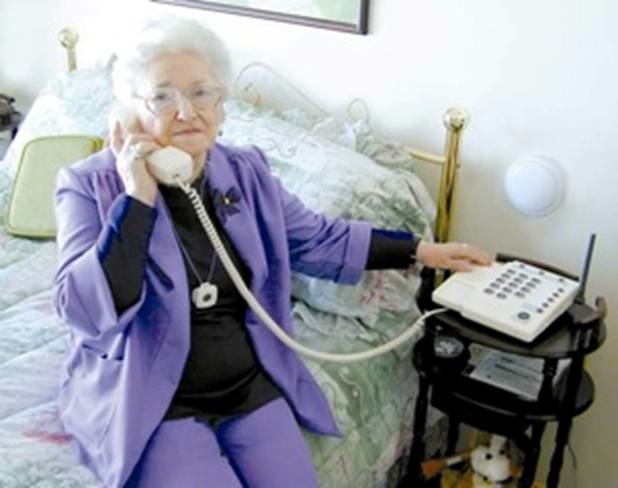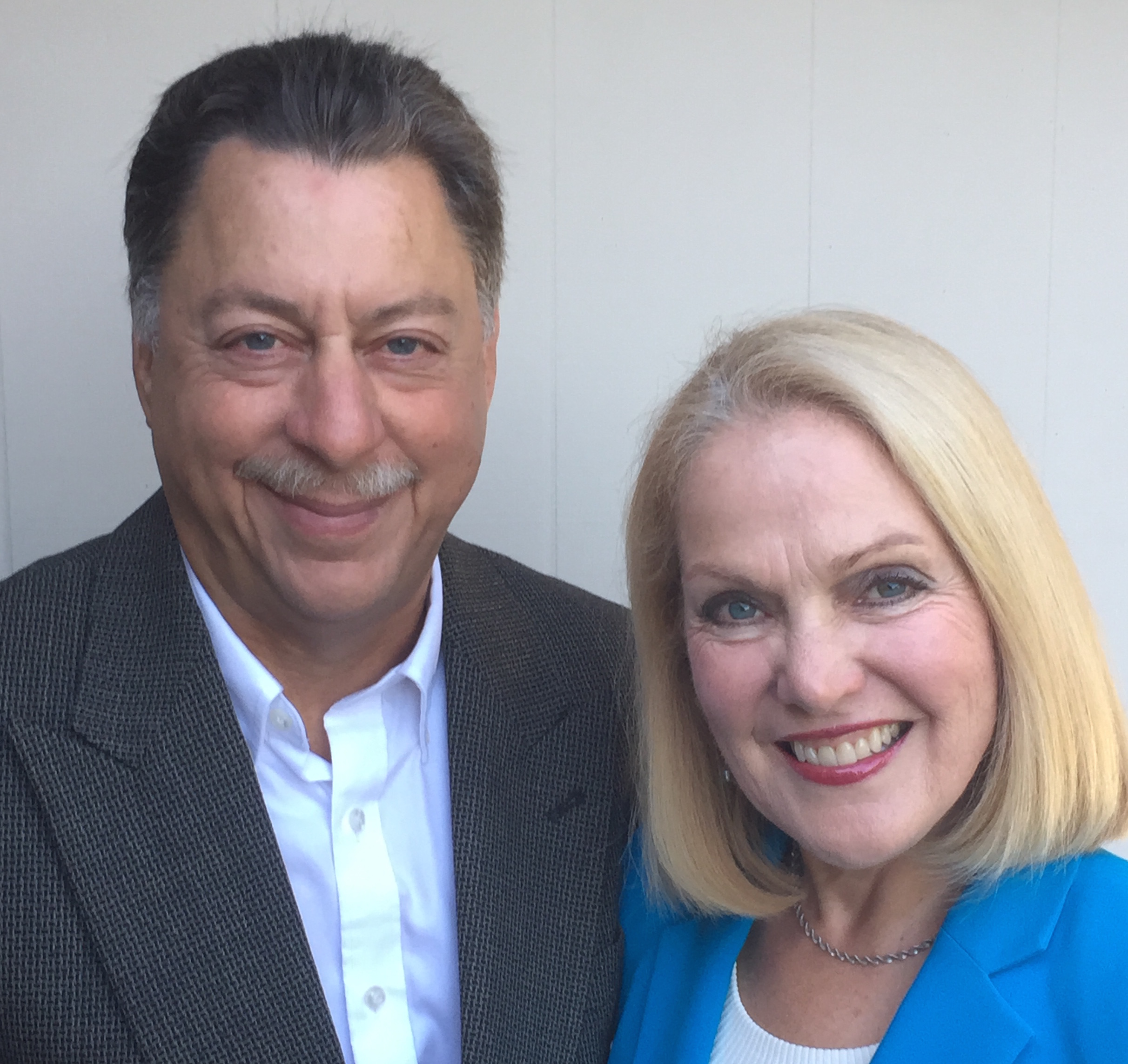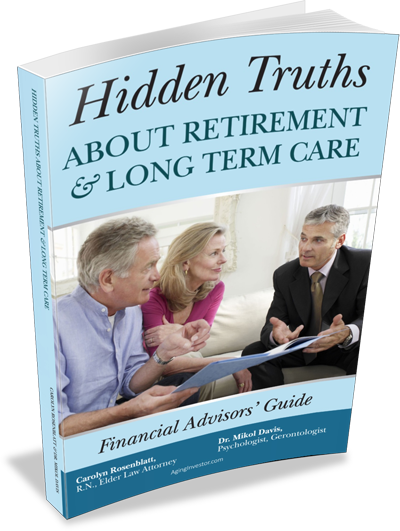
Dec 8, 2020 | aging, aging in place, cost of aging, cost of long term care, financial advisors, handling money for aging parents, long term care, retirement, retirement planning
Few things are more stressful than family disagreements, especially related to helping an aging family member. You’re invited to a VIP Virtual Event: How to Resolve Family Conflicts, Care, Control and Money Approaches from Legal, Psychological and Compassionate Perspectives
Wednesday, December 9 I 4:00 – 5:00 pm Pacific Standard Time
Featuring special guest speakers Carolyn L. Rosenblatt, RN, Attorney and Dr. Mikol Davis, Psychologist of AgingParents.com
RSVP david@eleganceatnovato.com (Link will be provided with RSVP)
The first 20 attendees to RSVP will receive “The Family Guide to Aging Parents: Answers to Your Legal, Financial and Healthcare Questions,”  by Carolyn L. Rosenblatt.
by Carolyn L. Rosenblatt.

Nov 12, 2020 | aging, cost of aging, elderly, handling money for aging parents, handling money for seniors, nursing home
If you have any older clients, this real case is one you should know about. Here at AgingInvestor.com, where we also serve families of your clientele, we see some horror stories and this one should wake us all up. It really happened. We think it could have been prevented if only someone had acted sooner. The names are changed, but the facts are not. Imagine that this 83 year old man is your client. You’ve known him over many years. He is what some refer to as an “elder orphan”. He has no kids, He’s widowed and was always very independent. No one paid much attention to him as he aged. He had about $1M invested, and his advisor figured that at his rate of withdrawal, he would be fine, probably for his life expectancy. It never dawned on his advisor to ask about his safety at home, whether he needed any help day-to-day, or if he had identified a trusted contact. Right now, after horrible abuse lasting four years, he is lucky to be alive. “Tony” lived alone and took care of himself. But he was getting frail and it was getting hard to get the grocery shopping done. While at the market, a checker seemed to befriend him and asked if he needed help at home. He agreed that he did. What he didn’t know was that the checker, Mae, who had no caregiving experience, had targeted him. Her evil intent played out. Almost immediately after offering to help, she moved into his house. His advisor never asked about his relationships at the annual portfolio review, and the adage “know your client” was ignored. Mae swiftly got control over his life and finances. The help Tony needed became her weapon. She refused to take him to the doctor or dentist despite severe hip pain and dental problems. He needed food, but she deprived him until he did as she demanded, giving her Power of Attorney. She went so far as to force him to marry her, taking him to another city, and then threatening to dump him there unless he married her secretly. He was helpless to resist. Changes to the authorized signatory on his account happened, but the advisor thought nothing of it. He never asked. Tony appeared to be suddenly married, but the advisor just changed documents and never had a conversation with Tony about it, despite his being 83 at that time. As his “wife” Mae seized his bank accounts, pension deposits, safe deposit box with gold in it, and all of his valuables. She isolated him from everyone who knew him. He was cut off for years, trapped and not knowing how to escape. She hit him, left him in ragged clothing and threw his dog against the wall. He had some memory issues but he did remember he had nieces and nephews. When Mae was out of the house one day, he made a desperate call to his nephew, with whom he had been close in years back. He begged for help. The nephew sprang into action. He summoned his 3 siblings, including one out of state, and together, they rescued Uncle Tony and brought him home. Tony’s nephew knew a lawyer who got an emergency court order to remove the “wife” from Tony’s house. Mae had to be escorted out by the police who initially resisted because Tony and the caregiver were married. It was stunning how the police believed the evil caregiver and not Tony nor his family members. Even with a court order in hand, the police were hesitant to evict Mae. His two capable nieces took over and addressed his needs. One moved in with her uncle to protect him for good. Tony is safe at this time and Mae will never have access to him again. Lawsuits are pending. He may never get his money or valuables back but at least he has his home and some relatives to step in. Some elder orphans have no one. How did this happen while an advisor managing his account saw it being drained by his “wife” over time? This is the most important point of the story for any advisor with aging clients who are alone, with no nearby family to watch out for them. YOU the advisor need to be watching out. The Takeaways Tony, an “elder orphan” made an easy target. Think about your older investors. How many live alone and have no family? It is well worth your time to ask them. Five things every advisor should do with any older client who is living alone and has no family are these:
- Check in with your older clients as often as quarterly, rather than once a year. Ask questions about how things are at home. The $700,000 Mae stole from Tony could have paid for a lot of care or help at home.
- That suggestion by regulators that you should “try” to get a trusted contact for every client must not be an option. You must insist on getting a trusted contact, especially for elders. (We recommend you get more than one!) Elder orphans may not act promptly when suspicious activity comes up but you can. When Mae made constant withdrawals from Tony’s account, the trusted contact should have been called. He was 83. That’s a red flag by itself.
- Know your client. That means general living situation, whether any family is around, and some basics about their health and independence. It’s not nosy to ask. It’s part of your job.
Brutal people taking advantage of aging clients, as Mae did are out there looking for victims. When you know your client, and you are paying attention, you are like the family they don’t have: you can keep them safe. By Carolyn Rosenblatt, RN, Attorney, Consultant
|
|
Dr. Mikol Davis and Carolyn Rosenblatt, co-founders of AgingInvestor.com
Carolyn Rosenblatt, RN, Elder Law Attorney offers a wealth of experience with aging to help you create tools so you can skillfully manage your aging clients. You will understand your rights and theirs so you can stay safe and keep them safe too.
Dr. Mikol Davis, Psychologist, Gerontologist offers in depth of knowledge about diminished financial capacity in older adults to help you strategize best practices so you can protect your vulnerable aging clients.
They are the authors of "Succeed With Senior Clients: A Financial Advisors Guide To Best Practice," and "Hidden Truths About Retirement And Long Term Care," available at AgingInvestor.com offers accredited cutting edge on-line continuing education courses for financial professionals wanting to expand their expertise in best practices for their aging clients. To learn more about our courses click HERE
|

Oct 9, 2020 | aging, aging investor, elder investor, elderly, finances for elders, financial advisors, financial capacity, financial judgement, handling money for aging parents, senior investor
Financial professionals often use the term “financial wellness”, referring to a client’s comfort level with their assets in retirement. That sounds good. But is there any connection between finances and wellness of the body and mind in retirement? Perhaps there is a vague belief that if you’re financially secure, all is well. In reality, how much money you have does not automatically make you physically nor mentally well, nor does it protect anyone against the one thing many people fear most: Alzheimer’s disease. Dementias are no respecters of the wealthy. No one is immune to brain disease.
You may hear the well-worn adage, “Without your health, you have nothing”. OK, that’s not completely true either. Even with declining health related to aging, you may still have excellent quality of life. That is a matter of perspective, and a matter of using assets you have to make the most of life, even with disabling conditions. The one factor that makes for a more secure longevity is what you can afford in terms of care, as aging takes its toll on independence.
Research clearly shows that how we live our lives, our healthy habits or lack of them is responsible for about 70% of how we age. Aging is different for each person, with the other 30% of the picture directed by genetics. Suppose you have a client with longevity running in the family. That may affect your client’s life span but it will not guarantee a great “health span”; i.e., how long one is healthy. What we already see with our aging population is an increase in disabling illnesses in seniors coping with diabetes, heart disease, obesity, high blood pressure and yes, Alzheimer’s disease and other dementias. Genetically predisposed to live long? How fun can it be to live to be 100 if you have a combination of these illnesses, cutting off the things that make life worth living for most of us?
It is extremely unlikely that any financial professional is going to convince a client to lose weight, exercise, stop smoking or cut out junk food so they can enjoy retirement more. That’s not your job. Managing assets is your job and the assurance you can provide is that your client, with a strategically managed investment portfolio, will be able to afford high quality care in old age.
What does high quality care mean for one’s retirement years? It means that if enough assets are available, your client will never have to go to a nursing home. It means that they can afford well trained caregivers at home from high quality agencies, licensed, bonded and insured.
Here’s an example from real life with one of our clients at AgingParents.com, the companion site to AgingInvestor.com. Timothy is 97 years old, living in a lovely home he’s been in since 1960. He is widowed. He needs a walker. He doesn’t cook for himself. He’s very alert but with lung disease, he’s frail. He has a high-end agency providing care management as well as caregivers day and night. He has the means and the right to spend his last days in his own home. Even if his health deteriorates further, he can afford a Registered Nurse to oversee his treatment or give additional skilled care to him at home. Licensed home health agencies can give skilled nursing to anyone at home for a price. A concierge physician can also visit him at home and direct the medical treatment for any illness or chronic condition. That is high quality care, and it comes only at a high quality price.
If you are in the business of managing client assets as they age, don’t just talk about how fun retirement will look at age 90 because they have plenty to spend. That may not be true at all if health is an issue. At that age, declining health is usually problematic. Be truthful. Let your clients know about how you are working to protect them in longevity, no matter what health conditions they may face. That protective spirit feels good to people, knowing you’re watching out for them and that you support the notion of staying in one’s home to the end of life. You have foresight they may lack. And you know the dollars they’ll need for what is likely to become necessary with long life.
If you do not know details of just what dollars those are, the nuts and bolts of how much it actually costs to pay for the numerous kinds of care a person may need, you can quickly find out. It’s laid out for you in our book, Hidden Truths About Retirement & Long Term Care, available at AgingInvestor.com and on Amazon. Increase your expertise! Get your copy today by clicking here
By Carolyn Rosenblatt, RN, Attorney, AgingInvestor.com and AgingParents.com

Nov 13, 2019 | ageist, aging, aging investor, declining health, diminished cognition, elder investor, elderly, finances for elders, financial advisors, financial capacity, financial judgement, handling money for aging parents, handling money for seniors, investor, retirement, senior investor, seniors finances
At its Senior Protection Conference on November 12, 2019, FINRA took a cell phone poll of broker-dealers. They wanted to find out how many were worried about aging registered representatives at their firms. The result: 65% were worried, according to the report published in Financial Advisor. Yes, aging B-Ds are a problem.
Here at AgingInvestor.com, we’ve been sounding the alarm about this problem since 2016, when we published our book, Succeed With Senior Clients: A Financial Advisor’s Guide to Best Practices. “The Elephant in the Room” chapter dives into how impairment in advisors affects the industry and how that most definitely will affect their work with clients. A B-D or advisor whose memory and judgment are impaired, even in the early stages, can expose the firm to liability for mistakes these folks make. Cognitive decline should not be taken lightly.
The speakers at the conference offered attendees very little concrete advice on how to address the problem of an impaired advisor. What could one expect of them? They have no training nor skill set in identifying diminished capacity themselves. Without expertise, their discussions lack action plans.
As aging experts ourselves (RN, Elder law attorney and geriatric psychologist) and a resource to the industry, we question the suggestion that one should wait for “performance issues” to surface before any firm does anything about an impaired professional in its midst. If there is a “performance issue” visible to management, it is likely that it existed for some time and harm to clients already could have occurred. The notion is reactive, not proactive. Isn’t that contrary to the essential philosophy of financial planning itself to look ahead, strategize and don’t wait for a crisis??
Waiting for a manager to call a special team assigned to address the problem is not the best approach, as we see it. For one thing, most firms don’t have a special team that would serve the purpose of knowing what to do with an impaired advisor. Yes, every firm would be well protected if such a team were formed and that is something we always recommend. However, failing to screen advisors with any in-house tools when impairment is suspected is to ignore the lurking possibility of harm to clients. What do we mean by an in-house tool? Start with a checklist.
On our website is a free downloadable Financial Advisor’s Checklist: 10 Red Flags of Diminished Capacity to help you spot the warning signs in clients. There is no reason any firm could not use relevant parts of the same tool to spot signs of diminished capacity in its own employees. It is not across-the-board applicable to the professional as compared with a client showing red flags but some points do apply to anyone. For example, memory loss, failure to appreciate the consequences of decisions, confusion, loss of ability to process basic concepts are all on the checklist and are universal warning signs.
What Can You Do With An Advisor You Think Is Impaired?
Proactive steps are essential. Here are our recommendations:
- First, record your observations of changes in the advisor’s behavior. For example, forgetting appointments, failure to meet on schedule with clients, seeing too many blank stares in your interactions with him or her, becoming withdrawn from interactions can all be signs of trouble a manager must address. They could be associated with cognitive impairment or with other health conditions. Managers need to ask the advisor about what they and other colleagues see that looks like a possible red flag.
- Ask about general health issues, which can directly impact how an advisor does the job of handling clients. Is it nosy? Yes. Is client financial safety at stake if you don’t ask? Yes. Take the risk of opening the conversation. That is smart. Waiting for a disaster is not.
- Establish an in-house policy for what should be recorded by colleagues and reported to managers about possible signs of cognitive decline and the direction you want to take after signs are identified. The policy should be in writing and distributed.
- Have a plan to closely watch the apparently impaired advisor.
Asking the advisor to work with someone to supervise transactions is one option. Reviewing how the advisor is managing his or her work at short intervals is another option. And with obviously impaired folks who do not themselves recognize their own cognitive changes (not an uncommon thing), have a suspension or graceful exit means to stop the impaired person from putting clients at risk. This falls under what those conference speakers vaguely referred to as “other arrangements”. Be specific.
This is uncomfortable territory for managers, compliance officers and for colleagues of older advisors in firms. However, the FINRA poll is telling. If this problem were not rising in our midst, 65% of those polled would not be worried. If you are concerned where you work, get your copy of Succeed With Senior Clients: A Financial Advisor’s Guide to Best Practices, now or get a live or online presentation from us at AgingInvestor.com. Don’t put your firm and your clients at unnecessary risk.
By Carolyn Rosenblatt, RN, Elder law attorney, Consultant, AgingInvestor.com

May 9, 2019 | aging, aging investor, cost of aging, declining health, diminished cognition, elder investor, elderly, finances for elders, financial advisors, financial capacity, financial elder abuse, financial judgement, handling money for aging parents, handling money for seniors, resources for senior, resources for seniors, scammers, senior citizen investor, senior investor, seniors finances
The Senior Safe Act allows you to hold transactions when you suspect financial abuse of a client. The Act is designed, at least in theory, to allow time for the trusted contacts you have on file to take appropriate action. Many of those victimized by predators or manipulated by unscrupulous family have dementia and have lost their judgment about what makes sense financially. The Act urges you to get trusted contacts and provides that you are not breaking privacy rules to contact them in the reasonable belief that your client is being financially abused. The length of time you can hold a requested transaction can be as long as a month. This is where the Senior Safe Act has missed the mark.
Let’s look at the reality of impaired elders who are in charge of their wealth on the family trust. The trust is in order, and if the elder recognizes that he or she is experiencing decline in mental ability, that trustee may choose to resign. Simple. But that is not what happens in too many cases. For many persons who have cognitive decline and dementia, the elder does not recognize that he is impaired at all. “I feel fine!” he tells his worried family. When asked to resign as trustee, having total control over (theoretically) millions of dollars in a trust, the elder flatly and stubbornly refuses. Meanwhile, financial abuse by predatory people can continue unabated.
When an older person experiences cognitive decline, it typically has a very slow onset. Short-term memory loss does not raise enough red flags for those closest to the elder to take any action. “She’s just getting old” they say dismissively. But memory loss is often the first and earliest warning sign of Alzheimer’s disease, the most common form of dementia. The odds of having Alzheimer’s disease by age 85 are at least one in three. Think about your own older clients. Some live well beyond age 85. The risk of dementia rises with age. Short-term memory loss interfering with daily life is not a normal part of aging. Financial abuse and cognitive impairment often go together.
When financial abuse reaches a visible level, the advisor may do what the law allows and call the trusted contact person, usually an adult child. The advisor hopes that the call will somehow trigger something and the abuse will be stopped. But here is a reality check: The family can’t accomplish anything needed in two weeks or even a month if you hold transactions then. Here is a real case example of just such a situation, showing how long it really did take.
In our work with a family at AgingParents.com we saw rampant financial abuse of an elder by a family member. The elder had dementia but had not been formally diagnosed by his doctor. Over 70% of his income was going to the predator. He was asked to resign as trustee by his two adult children, who were reasonably worried that he was going to give away all his cash and further encumber his home. The dad, whom we’ll call Gene, had been developing dementia for at least two years. He felt obligated to the predator and was totally powerless in resisting her demands for money. He just kept writing checks, draining his own resources. It was clearly a case of financial manipulation.
We were involved in working to persuade Gene to allow what his family trust provided: to have his daughter, Jennie, become the successor trustee. He agreed, then reneged. He accepted the logic and then refused to accept it. The kids had no choice but to use the law to take over control. Their father was too stubborn to resign as trustee when asked, even with the entire family presenting a united front, asking and respectfully begging.
The trust, like many such documents provided that Gene could be removed as trustee by his appointed successor, his daughter, after two physicians had declared him to be incapacitated for handling his own finances. A court decision was not required. However, getting him to two doctors willing to assess him and put their observations in writing was a challenge that took months to accomplish. The total time spent getting the change of trustees accomplished according to the terms of Gene’s trust was eight months.
His children were the trusted contacts in the advisor’s file. They knew about the abuse and were in agreement with the advisor that Gene had to stop being the trustee. The adult children had to hire consultants (AgingParents.com), have meetings, hire an attorney, and try various methods to get the job done. Their time energy and thousands of dollars were expended to prevent an even worse outcome, which was being left to support their aging father if he were to totally deplete his own funds.
The takeaways:
- Though well intended, we do not expect that the Senior Safe Act will do much to stop financial abuse because of the short time allowed for a financial professional to hold transactions. In Gene’s case, the predator would have been happy to wait a mere two weeks or a month before resuming the financial manipulation of Gene.
- Know that any older impaired client may not understand that he or she is cognitively impaired and will ignore pleas to resign as trustee with total control over any family trust.
- If you see that an older client is showing signs of cognitive decline, do not wait until it gets worse. Reach out at the time of your first suspicions of trouble. The family or other trusted persons may well have a better opportunity to persuade an elder to transfer power over finances to the appointed successor before complete loss of capacity. Expect this to take time.
In the case described above as a result of ongoing financial abuse, nearly all of Gene’s cash was depleted during the eight months of effort on the part of his adult children to have him removed. The advisor did the right thing but too much of Gene’s cash was depleted in the period when the abuser could keep manipulating him for those months of effort by family to have him removed as trustee.
By Carolyn L. Rosenblatt, RN, Elder law attorney, AgingInvestor.com
If you are seeing abuse and feel lost about how to stop it, contact us at AgingInvestor.com for a confidential consultation with our nurse-lawyer, geriatric psychologist team so you can do everything possible to protect your vulnerable client.

Feb 21, 2019 | aging, aging investor, cost of aging, cost of long term care, declining health, elderly, finances for elders, financial advisors, handling money for aging parents, handling money for seniors, health, long term care insurance, resources for senior, resources for seniors, retirement planning, senior citizen investor, senior investor, seniors finances
It used to be that we could think of retirement in a kind of predictable way. People lived into their 70s perhaps, and we measured retirement by that. We used tables, algorithms and other tools to tell us how much we should save and how much we could spend in retirement. And it was all based on assumptions that may no longer apply.
Life expectancy for a woman in the U.S. in 2018 was 84 years. For a man, the figure is 80 years. Those averages do not take into account the fact that well educated and financially secure people live longer than average. This is presumably based on the notion that people who know what a healthy lifestyle is and who can afford the best medical care will outlive those who do not have those advantages. In my own county, for example, which has a high proportion of elders compared to other counties in California, one wealthy city shows a life expectancy for men of 93 years.
Suppose that your aging client lives to be 93, having retired at age 65. That’s 28 years of retirement. What the algorithms don’t clarify is what you, the advisor needs to plan for with your client during the last decade of life, from 83-93. No formula is going to help you with the individual discriminations you need to make concerning your client’s risks for care and how to assess and plan for them. They can be a substantial cost, out of pocket, not covered by Medicare, and absolutely necessary.
The way we age is determined by two main factors: hereditary tendency and lifestyle. Our genetic makeup directs only about 30% of the equation. The other 70% is driven by the way we choose to live our lives. There are plenty of folks who think that a healthy lifestyle is just too much bother. They avoid exercise, eat whatever they feel like eating, never learn to manage stress and say they’d rather die a few years sooner than give up their habits, which their doctor advises against.
Here’s the problem with that belief. Leading an unhealthy lifestyle does not just cause you to “die sooner”. Rather, it may likely cause you to live with impairments, disabilities and a need for expensive long term care for chronic health conditions. These can go on for decades.
Take obesity, for example. Over two-thirds of Americans are overweight or obese. Obviously excess weight increases our risks for all manner of health issues, including diabetes, heart disease, high blood pressure, and strokes. When a doctor makes a diagnosis of one of these, the person doesn’t typically just die on the spot and save a lot of expense later on. No. The medical providers will keep the person going with medications, surgery in some cases, lots of diagnostic monitoring and trips to the doctors. These chronic conditions usually lead to disability late in life, particularly when more than one of them exists in the same person.
If you have aging clients, you definitely need to understand health risks in a basic way, so that you can help your clients set aside funds for the care they are likely to need in the last years of their retirement lives. All of the chronic conditions I mentioned are manageable with an effort toward a healthy lifestyle but for those who do not wish to do the work involved, you can bet on a likely need for long term care. While you can’t predict the future, you can plan for risk. It’s what you do.
My own mother in law had high blood pressure and chronic kidney disease for decades. She worked vigorously at diet, exercise, social activities and other components of a healthy lifestyle. Heredity was not on her side. She lived to be 96. During the last 3 years of her life, she needed help. She moved to a seniors’ community where help was available and eventually, she paid for private caregivers. Her cost of living at the last part of her life was $120,000 a year. If this were your client, would he or she have at the ready $360,000 to pay for care? How about if there was no pursuit of a great lifestyle? The care expense could easily be 10 years.
The takeaway here is that advising for longevity needs to include the skill of assessing fundamental health risks that create a need for out of pocket, long term care. You don’t need to be a doctor and you can’t predict everything, but you can do what is reasonable to help your client plan. Ask the right questions. Keep track of your client’s general health picture.
To learn more about what to look for and what to ask, get Hidden Truths About Retirement & Long Term Care, available at AgingInvestor.com and on Amazon.
By Carolyn L. Rosenblatt, RN, Elder law attorney, AgingInvestor.com

Feb 13, 2019 | ageist, aging investor, elder investor, elderly, finances for elders, financial advisors, handling money for aging parents, handling money for seniors, investor, retirement planning, senior citizen investor, senior investor, seniors finances
In a conversation with a prominent retired financial advisor from a large institution, I heard the following:
“Financial advisors are not interested in retired people. They’re taking money out. The advisors are interested in investors who are putting money in, not the other way around.”
Just hearing this generalization, whether true or not, gave me a kind of sick feeling in the pit of my stomach. Millions of Boomers fall into this category of retired. If their advisors lose interest in them when they are no longer increasing their investments, where does that leave the retired person in need of advice? The generalization sounded like age discrimination.
As a professional devoted to the well-being, financial safety and quality of life of older adults, I can only hope the statements I heard about lack of interest are untrue. I have met plenty of financial advisors who are indeed interested in maintaining their relationships with their oldest clients, not just based on whether the portfolio is increasing. They actually do care about the clients. For them, it’s not just an empty advertising slogan. I hope this is the majority!
Millions of clients served by advisors will retire soon enough or these clients are already in that phase of their lives. Competent financial advisors who have the ethics they hold themselves out as having will increase their skills in planning for lifespans for some of their clients who will live into their 90s and beyond. No logarithm nor mathematical table will do a complete job of this.
Here are some of the areas involved in longevity planning that the best advisors will fully understand by their increased training and preparation:
- Social Security, and how to maximize the benefit.
Particularly with married couples, this requires specialized knowledge in order to give appropriate advice. When I asked my own long time B-D at our financial institution about it, he was very vague and couldn’t even refer me to anyone who could answer questions my husband and I raised. We fired him. We found an independent advisor who was very knowledgeable about Social Security. We referred three other people to this new advisor in the meantime and all became his clients. Take heed. Word spreads.
- Long term care planning.
Telling a client who is reluctant to purchase long term care insurance that self-insuring is a choice is fine, but the longevity advisor understands how to address the risk of needing long term care and has actual figures at hand to spell this out for the client. If this is not your area of expertise, you can get a clear understanding of the costs of all types of long term care in my book, Hidden Truths About Retirement & Long Term Care. About 70% of people will need some long term care at some point. Know what it costs.
- The nexus between financial planning and estate planning.
It never fails to surprise me about the disconnect between the financial advisor and the client’s estate planning attorney. Both should be working together to ensure that the client’s later years are financially safe. Successor trustees should be known by both the advisor and the lawyer, so that if a client begins to show cognitive decline, they can coordinate efforts to have the named successor take over decision making at the appropriate time. If you are worried about confidentiality of protected information, get the client’s permission in advance of any impairments, to communicate with the attorney involved. In other words, do this at the time of retirement.
- Targeting relationship building with the next generation.
- A loss of interest in a retired client deprives the advisor of a huge opportunity. That is, to establish a connection to and trust with your retired client’s heirs. Have you even spoken with any of them at the point of the aging investor’s retirement? If not, you have an explanation for the reason why about 80% of the heirs move their inherited assets to someone else after the patriarch or matriarch dies. The heirs can get to know you well in advance if you invite them, with your client’s permission of course, into the planning conversations. Don’t lose that chance.
In a nutshell, the older client needs the skill the financial advisor has and retirement should not change the advisor’s interest level. Keeping clients for life takes an understanding of longevity. Make it your business to do just that.
Carolyn L. Rosenblatt, RN, Elder law attorney, AgingInvestor.com

Feb 5, 2019 | aging, cost of aging, cost of long term care, custodial care, declining health, elderly, finances for elders, financial advisors, handling money for aging parents, handling money for seniors, health, long term care, nursing home, resources for senior, resources for seniors, retirement planning, seniors finances
The financial services industry often refers to retirement planning for the future with aging clients in terms of “housing choices”. This reflects some degree of misperception about what happens as we age. For healthy people of retirement age, there is little interest in planning for the need for care and planning for loss of independence. People usually resist talking about it. We don’t choose to lose our independence. It happens. It is up to the advisor to raise it if you want to advise for longevity. The subject is emotional and can be difficult.
Where we need to get help when we can’t be independent any longer is really a choice about care, rather than housing. This is not house shopping. Does a client want to pay for care in her own home when that time comes? Most would say yes, they want to remain at home. They then must calculate what a home care worker costs and whether that is the best way to receive the help they are likely to need one day with their activities. Can the resources be available to enable that choice of where care will be given?
If an elderly client is living alone and can’t manage at home anymore without assistance, there are indeed choices, often driven by the degree of care needed and the cost of getting it. Elders may not be interested any longer in maintaining a house, cooking, shopping, and other necessary chores. For them, assisted living may be desirable because their daily lives will be different and free from the burden of the household that has become unmanageable. The choice to go to assisted living is usually not one a client is going to make because of wanting to downsize into an apartment for its own sake. Rather that is the price of going to the place where assistance is on hand. Again it is to receive care, not because they love the idea of not having their home any longer. For many elders, downsizing from a house to an assisted living apartment is a difficult adjustment, required because of physical or mental changes of aging. From that perspective it is a choice forced upon them.
A factor every advisor should know is that the likelihood of living alone increases with age. Almost half of women age 75+ lived alone in 2010, according to the Institute on Aging. The “choice” of a different living arrangement is brought on by safety and care concerns, often raised by their adult children.
It will be good for every advisor who wants to help clients plan for longevity to consider that their role is to introduce the issue of possibly needing care in the future, as about 70% of us will one day. If your client has you in her life, she already has housing. Planning for “housing” is a misnomer. Focus on places and choices where care can be delivered. Having no care plan can be disastrous, as sudden health crises can force decisions without considering the cost of care in advance.
In helping to educate your client about where he or she can receive care, the costs of all the offerings available in most areas are spelled out in detail in our book, Hidden Truths About Retirement & Long Term Care. You can develop quick expertise on the subject there. Skilled advice about longevity for your aging clients requires knowing your numbers, what care options are available where they live and how much they can expect to spend for that care. Smart advisors gather the data before a crisis happens and urge clients to look at it with them.
By Carolyn L. Rosenblatt, RN, Elder law attorney, AgingInvestor.com

Jan 27, 2019 | aging, aging investor, financial advisors, financial capacity, financial elder abuse, financial judgement, handling money for aging parents, handling money for seniors, seniors finances
Scams, theft and fraud with seniors’ money is a growing problem. Now the Wall Street Journal reports that banks in our country calculated a 12% increase in financial elder abuse just in the last year. Why do the thieves pick on grandma or grandpa so much? It looks so ugly to take advantage of an elder.
Your aging clients, whether getting advice or investing in your institution, are targets without a doubt. They hold a disproportionate amount of our country’s wealth. And you can help stop them from being victimized. Over $36B a year is stolen from elders in the U.S. alone.
Your aging parents are easy targets for scammerThe Ss for lots of reasons. Elders in this country hold a disproportionately high level of wealth compared to younger people. Some have accumulated significant assets and they may not see themselves as vulnerable at all. Clearly, diminishing cognition makes it easy for thieves and manipulators. Cognitive decline affects at least a third of people over age 85. Your aging client may not have the awareness any longer to spot a fishy-sounding line from anyone. Widowed clients live alone and are isolated, ready to engage with that friendly sounding, cheerful voice from the clever scammer on the phone.
Thieves stay in contact and weave a trap over time. Many aging folks are dependent on others for care, for help at home and for social contact. Dependency makes them vulnerable. Unscrupulous family members lead the pack of those who seize on that vulnerability and trust to rip off their elders. It’s all too easy to influence an aging person to give a “loan”, access to an account, or power of attorney to a person with ulterior motives, which essentially creates a license to steal. Eventually they all want your elderly client to give them money. That’s where your awareness can thwart them.
Banks are making efforts step up their reporting of suspected elder abuse, but that is not enough to thwart the crime. The Senior Safe Act gives you, the financial professional protection if you report suspected financial abuse. Great. But how about stepping up your contact and review of transactions with any elderly client before abuse happens? Too often, the customer-facing bank employee does not see anything wrong until far too much money has been drained from the elder’s account. After the abuse has occurred, it is too late to get the money back. And there is hesitation at the banks, even when they are warned. To put bluntly, banks can add to the problem.
One example of this involved a client of ours at AgingParents.com where we consult with families and elders. She was the daughter of an 87 year old dad who had some memory problems and was frail, losing independence. Her father was a wealthy man, in a long-term relationship with a younger woman. She had manipulated him into giving her access to his family’s trust account into which his significant income was deposited each month.
The man’s daughter found out after a suspicious withdrawal from the account and she contacted the bank immediately. She traveled to her father’s state, went to the bank in person and showed them the trust, which did not have the girlfriend’s name on it anywhere. She asked them to stop the access by the girlfriend. The bank complied and put the funds into an account to which the girlfriend did not have access. After the man’s daughter left the state, the girlfriend took the elder back to the bank and told him to say that he wanted her on the account. Presto! The bank complied and the girlfriend then had access once again, only one day later. The bank aided the girlfriend in financial abuse of their own elderly customer, despite a specific request to stop it and evidence of manipulation. The matter ended up in litigation. We can only say “how ridiculous!” The financial professional, bank employee or manager should have known better. The picture was classic: warning had been given, paperwork proving the problem was given to the bank, and the bank agreed to take the pushy girlfriend off the account. Then they turned around the next day and did the opposite, just because the elderly customer was standing there. Never mind that he was manipulated into saying what the woman told him to say, prodding him as he stood there. That kind of scenario is what needs to change.
If you are now supposed to report abuse, you definitely need to know what the red flags of diminished capacity look like and how to see the warning signs of financial abuse. At AgingInvestor.com, we offer accredited courses to train financial service employees, compliance officers and managers in how to spot warning signs of cognitive decline and financial elder abuse.
Get your free checklist of the red flags of diminished capacity here.
Here are some takeaways:
1.The Senior Safe Act gives you some immunity if you report abuse. It offers you no guidance in how to spot elder financial abuse.
2. Aging clients with diminished capacity are, of course, much more vulnerable to manipulation by an unscrupulous romantic “friend”, family member or stranger on the phone or internet. They need your protection.
3. Odds are that by the time you report suspected abuse, the money is already gone and authorities cannot get it back. It makes more sense to be proactive in protecting aging clients rather than merely reporting abuse. Learn about how to do that by training.
By Carolyn Rosenblatt, RN, Elder law attorney, AgingInvestor.com

Jan 18, 2019 | aging, aging in place, aging investor, cost of aging, declining health, elderly, finances for elders, financial advisors, handling money for aging parents, handling money for seniors, health, long term care, resources for seniors, retirement planning, seniors finances
Most advisors who even ask this question of their
retirement-aged clients never spend time on it. About 90% of those asked say
they want to remain in their own homes as long as possible. That sounds fine. Until one faces physical
decline, cognitive impairment or both. The advisor providing competent guidance
about financing aging at home had better know the facts.
None of us like to think about losing physical ability or needing help. We abhor the thought of losing our total independence. In our view at AgingInvestor.com, the only advice clients are getting is about the long term picture is whether or not to purchase long term care insurance. Since most people don’t do that, the actual costs of living at home can boggle the mind. It’s the best advisor’s obligation to educate your client about the risks of the plan to age in place, just as it is your obligation to educate them about balancing their portfolios. You are giving the client added value if you take the time to talk them through the risks and dollars they may need to have available.
Here are some briefly stated facts from a real case in which
an 89 year old wanted to age in place and his wife promised he would never have
to leave home.
At the outset of his declining health, he had about $3M in
invested assets. His portfolio was healthy and balanced for his age, according
to conventional wisdom. He began to lose his ability to walk due to multiple
medical problems. His wife hired home helpers, three days a week at first. As
his conditions progressed he needed more and more help. He had to have a wheelchair, and a special
van. A stair chair was installed in their two-story home. By the time he
reached age 95, he was spending over $150,000 a year on care and assistance
around the clock. In the space of time during which he was steadily losing
independence until he passed away at 95, his assets were depleted to the tune
of $2M. He lived in a higher end market for the needed help but the reality is
that in any market, the kind of care he needed would be very expensive.
For him, aging in place was more costly than a skilled
nursing facility would have been. Home modifications, private caregivers, (none
of whom were licensed nurses), equipment, medications, adaptive devices, etc.
drained his resources by 2/3. And not everyone has as much invested as he had
to even start the journey. His wife had her own assets and she paid the cost of
household maintenance, taxes, food, and utilities with her funds. Had she
relied on him for those things too, there would likely have been little left at
the end of his life.
It is not all doom and gloom however. Many clients live rather well in their last years without all the care this gentleman needed. Some get by with family caregiving help, and some have fewer medical conditions. But if you are going to competently help your clients plan for longevity, it’s essential to understand the real out of pocket costs of aging in place or anywhere else outside the home. If you want to add value to your services to older clients, know what they need to know to properly anticipate what can happen with living into one’s 90s and beyond. Learn all the actual costs of care for every aging client option in our book, Hidden Truths About Retirement & Long Term Care. Be well prepared to walk your client through the scenarios they could face in their futures. You distinguish yourself from other advisors when you sharpen your knowledge in planning for longevity.
By Carolyn Rosenblatt, RN, Attorney, AgingInvestor.com

Nov 15, 2018 | aging, aging investor, cost of aging, cost of long term care, custodial care, declining health, elder investor, elderly, finances for elders, financial advisors, financial capacity, financial judgement, handling money for aging parents, handling money for seniors, health, investor, long term care, seniors finances
Your clients are getting ready for retirement. You’ve done the calculations, balanced the portfolio and advised them of what income to expect. You’ve discussed how much spending is ok. You used your program and your analysis was thorough. You’ve done your job, right?
Not exactly. There is probably no algorithm nor program that will calculate your client’s individual profile of health risks that will likely lead to the expense of long term care. That can be a whopper. Maybe you’ve suggested long term care insurance. Most people don’t choose to buy it. For those who do, the benefits are limited and the “elimination period” (deductible) is thousands of dollars. There go your careful calculations. At least 90% of folks don’t have that coverage. Now what?
But how can you predict what’s going to happen to anyone’s health in retirement, you ask. You can’t be precise, but you surely can make some rational observations and give advice accordingly. Those observations consist of two parts: what you can see with your own eyes and what you can glean by asking a few basic questions. If you think asking any client about their health conditions is too nosy or not your job, consider that if the client needs long term care and runs out of money because of it, they’re not going to think much of you. And the cost can wipe out their security.
Asking about health issues is not nosy at all. Rather, it’s what any smart advisor planning for longevity must do. Let’s not keep pretending that everyone stays the same physically and mentally from the start of retirement to end of life. Our bodies go through wear and tear and things break down. Cognitive decline affects at least a third of people who reach the age of 85. The risk of Alzheimer’s disease keeps climbing after that. Now, what was that life expectancy you were using in your calculation? Was it age 99?
Let’s start with what you can see in your client with your own eyes. (If they’re not in front of you, perhaps Skype is an option). Is your client obese, as about 40% of the U.S. population is? This leads to heart disease, stroke, and diabetes, among other diseases and conditions. The medical care people receive in many cases will save them from dying but they then live with disabilities. And yes, they will be very likely to need expensive long term care. Neither health insurance nor Medicare will cover long term care. Such help as a part time caregiver at home is how most folks start out with long term care. Your client pays out of pocket most of the time. Did you calculate how much it costs as well as how long they will likely need it? If they have multiple medical conditions, and have started long term care, they’ll probably continue to need some form of it for all their remaining years.
Find out what you may not know from simply observing your client’s appearance by asking questions. You can make your own list or get a health care provider to help you with a few targeted questions. You will need to educate your client as to the reason why you need this information. It’s to help them plan for how much to save in their retirement years.
Here are some examples of basic questions that can help you predict the need for possible long term care:
- How’s your health these days? Has a doctor told you that you have any long term conditions?
- Are you taking medications? What are they for?
- Do you smoke?
- Are you concerned at all about any health issues you have at this time?
- Do you recall your parents’ ages when they died?
Your aging clients will not be eager to talk about the potential need for long term care. When you told them about what to expect for “out of pocket medical costs in retirement”, you did not give them a figure that included long term care. Long term care is not “medical” according to Medicare. Rather, it is called “custodial care”. The client probably will not bring it up, so you must do this.
When you have done your observations and gotten answers to your health-risk related questions at least there is a place to start a meaningful conversation. You can give them figures as to the cost of typical kinds of care, such as a non-medical home care worker. We at AgingInvestor.com recommend starting your projections at age 80 as to when a person might need physical help. Many of us know someone who did require help with at least some part of his or her life at that age. Then you can talk about how any condition your client identifies for you, such as high blood pressure, diabetes, etc. as shortening normal life expectancy and increasing the risk for needing help. If your client already has difficulty with some normal daily activity such as walking or bathing, they are definitely at high risk for needing paid help sooner than a person without these problems.
Clients may be completely unaware of such things as the hourly cost of a home care worker, what assisted living costs each month and what home modifications cost if they are able to remain in their own home. You can find a thorough discussion of these and many other parts of long term care in our book, Hidden Truths About Retirement & Long Term Care, written specifically for financial advisors like you.
Every conscientious advisor needs to wake up to the reality that your retirement income calculator omits the reality check of health problems. We’re not talking about nursing homes, but every other kind of care and help most people will need as they age. If you do want to help clients who are reaching retirement age to plan realistically, include the health risks you can see or learn about by asking.
By Carolyn L. Rosenblatt, RN, Elder law attorney, AgingInvestor.com

Apr 18, 2018 | aging, aging investor, diminished cognition, elder investor, elderly, finances for elders, financial advisors, financial capacity, financial elder abuse, financial judgement, handling money for aging parents, handling money for seniors, seniors finances
It seems that regulators are fond of creating new mandates for you without telling you how to implement them and what risks might be involved. The new FINRA rule that says you must “try” to get a trusted contact person (TCP) for new clients is illustrative.
First of all there is no firm requirement that you actually get a TCP for anyone. All you have to do is make an attempt. If the client says “no”, you’re out of luck in trying to solve any problem that may exist without anyone to call in the event of an issue you see. Such issues might include someone ripping off your client or your client really losing his marbles. The intent of the rule was good. The idea was to increase protections for vulnerable elders. It’s just that the way clients act and the issues you are sure to see with one TCP have been ignored in regulators’ creation of this mandate.
Research has given us important information about protecting elders from financial abuse. We know that family members are the most frequent abusers of elders. Guess who most elders would think of as a TCP? The family member, of course. The idea of a single TCP is flawed from the outset. If the idea is to keep your client financially safer, you don’t want to be limited to the potential abuser as the TCP. That defeats the purpose.
Here at AgingInvestor.com we are on a mission to keep elders safer. We make every effort to fill in the blank places your regulators leave when they come up with a mandate like getting a TCP for your clients. Here are our recommendations on this subject and why we say what we say about TCPs.
First, we believe every advisor should not only “try” to get a TCP for every client–we think you should insist on it as a matter of your intelligent, proactive senior office policy. Every client, new and existing should be approached with a courteous, respectful explanation and request to name a TCP you can contact in case of need. You let clients know that you have a policy to protect them from potential predators who are out there trolling for your clients, particularly the seniors. You could write this explanation and request up and send it around or bring it up at every portfolio review.
Next, we recommend that you get not just one TCP for every client, but three. The reason for this is that since family members are often the abusers of vulnerable people, you need someone else to call if “sonny boy” is ripping off dad’s account and dad is too impaired to realize it. “Sonny boy” just might be the one TCP his dad, your client named and you would then be stuck with no way to protect your client in that situation. Someone outside the family would be ideal. This could be the estate attorney, a competent friend, or a clergy person your client trusts. Any of them would need to be able to intervene when learning of suspected financial abuse of your client. A third TCP could be another family member your client also sees as trustworthy. With information going from the advisor to three people at once, the risk of abuse is lessened and the chances of effective action in the event of abuse are increased.
Finally, we recommend that you consider all the risks involved in a decision to reach out to the TCP when you see red flags of diminished capacity in your client, or when you see warning signs of financial abuse of your client. You do need a written internal office policy that directs you as to the observations, documentation and steps to take when an issue comes to your attention. Legally, you are probably on firm ground, carrying out the intent of the FINRA regulation. However, you don’t want to set your client up for harm.
For instance, if the client is in the middle of a contentious divorce and the ex- spouse is the TCP, do you want to release information about your client’s finances that could harm your client in the divorce proceeding? Give yourself time to discuss the options with other, knowledgeable people in your office, or group. The value of having a proactive office policy for aging clients in this situation is that you have others to ask and weigh in with their points of view.
If you are not sure about the red flags of diminished capacity and what you should look for, get your free downloadable checklist here. Likewise if you are not clear about classic warning signs of financial abuse get your free checklist for those here too.
Need help with that smart, proactive senior office policy? Ask for a consultation at AgingInvestor.com and get the guidance you need from our nurse-lawyer, geriatric psychologist team
Carolyn Rosenblatt, RN, Elder law attorney, AgingInvestor.com
<p><code> </code></p><div class="signature"><table style="border: 2px solid #999; border-style: solid; background-color: #f5fff5;"><tbody><tr><td style="width: 110px; vertical-align: text-top; align-content: center;"><div style="border: 1px solid #eee;"><img class="alignleft" src="http://www.aginginvestor.com/wp-content/uploads/2015/04/DavisRosenblattPublicityPhoto.jpg" alt="" width="123" height="116"></div></td><td><h4>Dr. Mikol Davis and Carolyn Rosenblatt, co-founders of AgingInvestor.com</h4><p>Carolyn Rosenblatt, RN, Elder Law Attorney offers a wealth of experience with aging to help you create tools so you can skillfully manage your aging clients. You will understand your rights and theirs so you can stay safe and keep them safe too.</p><p>Dr. Mikol Davis, Psychologist, Gerontologist offers depth of knowledge about diminished financial capacity in older adults to help you strategize best practices so you can protect your vulnerable aging clients.</p><p><a href="http://www.aginginvestor.com" target="_blank" rel="noopener">AgingInvestors.com</a> offers accredited cutting edge on-line continuing education courses for financial professionals wanting to expand their expertise in best practices for their aging clients. To learn more about our courses click <a href="https://agingparents.leadpages.co/ceu-choices/" target="_blank" rel="noopener">HERE</a></p></td></tr></tbody></table></div>

Feb 13, 2018 | aging, aging investor, cost of aging, elder investor, finances for elders, financial advisors, financial capacity, financial elder abuse, financial judgement, finra, handling money for aging parents, handling money for seniors, investor, power of attorney, senior investor, seniors finances
The regulators are trying. They want to help advisors protect aging clients from financial abuse. They don’t want you to fear doing something wrong if you refrain from handing over assets to what looks like an abuser. But not living in the real world of how to stop abuse by determined abusers has its disadvantages. The new rule tells you who is at risk (elders and other impaired adults). It tells you that you just need a reasonable suspicion of abuse, not unquestioned evidence. It tells you what a temporary hold is and how long it can be: 15 days, 25 at max. Sounds ok. Until you actually know how long it takes for the legal steps to halt abuse.
Here at AgingInvestor.com we see this problem in the world of families and those who want to rip them off, not from inside an institutional setting or financial services firm. The world from here looks different from what FINRA imagines. There is usually no way anyone can stop abuse in 15 days or even in 25. We explain. In a real case, the kind this rule is designed to affect, we worked with family in an unfortunately typical situation of an unscrupulous son trying to squeeze money out of his 90 year old father who had dementia. The advisor had seen the pattern. He knew the son never did well on his own and he had been given handouts from dad for years. Dad, whom we’ll call Joe, lived in a nursing home. He needed help with everything and his memory was shot. He was easily confused. Yet his advisor never questioned his ability to effect financial transactions. But when the son, we’ll call Jake, brought his frail father into the advisor’s office demanding $50,000 plus access to the cash management account, the advisor was sure it was abuse. He knew his client was too confused to disagree with Jake. The advisor dragged his feet and didn’t provide the check his client had asked for, pushed by Jake, Over a month later, he felt obligated to give his client the $50K, which of course Jake got right away from Joe. The advisor didn’t have Rule 2165 but he knew that Joe’s daughter Rhoda was the appointed person as power of attorney and successor trustee. He didn’t have permission to contact her, so he did it, as he said “on the QT”. Rhoda was upset. She called us for advice. She found us through her own advisor who had the sense to send her to a resource who could answer her questions and guide her.
First we looked at the trust and what it said about Joe being removed as trustee or resigning as such. Two doctor’s letters were needed, verifying that he was no longer competent to manage finances if he was to be removed as trustee. We advised her to get those letters asap. Rhoda lived out of state from Joe. She found the doctors and flew into town to take him to the appointments. Fortunately the doctors were able to say that Joe had indeed lost his capacity for handling his money. A couple of weeks after the appointments, Rhoda got the letters she needed. She then had to take them to Joe’s estate planning attorney, who met with her and eventually gave her a Certificate of Trust, showing that she was now the successor to Joe and was in charge of his money. She then had to get the Certificate to his advisor’s firm, which had to review it and after two weeks, they accepted it. Only then was Rhoda able to stop any further disbursements from Joe’s account without her permission. Her brother was furious. His gravy train had stopped. The advisor had sent a debit card for the cash management account Joe requested under pressure to Rhoda, not to Joe. Rhoda destroyed it. Abuse stopped in its tracks.
Reality check: this scenario of stopping abuse involved a lawyer, an elder willing to go to two doctors, the cooperation of two doctors, travel between states, the approval of the Certificate of Trust with Rhoda’s name on it through a process by the advisor’s firm and a lot of time spent by Rhoda. The entire matter of protecting Joe from abuse took three months. Rule 2165 supposedly authorizes advisors to “take immediate action” when abuse is reasonably suspected. What is myth rather than reality is how long it takes to actually protect the elder and stop a predator. This was a case of undue influence by Jake who had a history of manipulating his father. And the new rule would not have helped at all. Jake would have happily waited for a mere 15 days to get his hands on the cash. Rhoda couldn’t possibly get Joe removed as his own trustee without the doctors’ letters. This sort of prerequisite of needing doctors to verify incapacity is commonly required in typical trusts. Perhaps the drafters of Rule 2165 never had to go through the process described here in their own lives. If they had, the new rule would provide for a 90 day authorization to hold transactions, rather than a maximum of 25 days. Maybe going forward when the myth gives way to reality, the rule will be revised. For now it is inadequate.
|
|
Dr. Mikol Davis and Carolyn Rosenblatt, co-founders of AgingInvestor.com
Carolyn Rosenblatt, RN, Elder Law Attorney offers a wealth of experience with aging to help you create tools so you can skillfully manage your aging clients. You will understand your rights and theirs so you can stay safe and keep them safe too.
Dr. Mikol Davis, Psychologist, Gerontologist offers in depth of knowledge about diminished financial capacity in older adults to help you strategize best practices so you can protect your vulnerable aging clients.
They are the authors of "Succeed With Senior Clients: A Financial Advisors Guide To Best Practice," and "Hidden Truths About Retirement And Long Term Care," available at AgingInvestor.com offers accredited cutting edge on-line continuing education courses for financial professionals wanting to expand their expertise in best practices for their aging clients. To learn more about our courses click HERE
|

May 8, 2017 | aging, aging investor, declining health, elder investor, elderly, finances for elders, financial advisors, financial capacity, financial elder abuse, financial judgement, handling money for aging parents, senior citizen investor, senior investor, seniors finances
Your older investors are sure it will never happen to them but Medicare fraud can trick anyone. Even those without a hint of cognitive decline can get taken by scammers. At AgingInvestor.com, we educate advisors about protecting clients from elder financial abuse and we thought we had our own family covered. With a 94 year old mother, we are especially alert. We were stunned when mom told us that someone “from Medicare” had called and asked her to “verify” her personal information.
Alice is a sharp 94 year old, living mostly independently in a seniors’ complex. She’s active, does her own shopping and is engaged with her neighbors in the community. She had an issue with Medicare not paying a bill for a service she had received some months prior. With our help, she had undertaken an appeal process, which involves a lot of repetitive paperwork. When a man saying he was from Medicare called, she thought it was about the appeal. Of course it wasn’t. The scammer asked her to “verify” her Social Security number, her address, date of birth and mother’s maiden name and she gave him that information.
A few hours later, she mentioned what had happened and said she had been wondering if it was right to give out that information. We were shocked! How is it that she didn’t see the potential ID thief when we talk about this all the time? We knew we had to jump on this right away to stop the thieves from using the information to open new accounts in her name. Hours were spent the next day calling the two banks where she had accounts, her credit card company, the credit reporting agencies and Social Security. We had to stop the auto debits on her bill payments. We cleaned up the mess.
So far so good. No unauthorized transactions have happened. Her old accounts were closed and new ones opened. Social Security sends her payments to the new account. Fraud alerts are on everything now. Whew! This was a lesson that even the alert older person can get fooled with the right pitch on the phone.
Here’s the takeaway.
Warn your clients: Medicare will NEVER call and ask you for your personal information. Never give it out unless you place a call to order something that you know is legitimate.
Medicare fraud can happen in many forms. This was just one of them. I believe that there was probably a connection between her Medicare appeal and the fraud attempt. It’s too much of a coincidence that they called when she had communication with Medicare going on already with her appeal. The appeal had not yet been resolved. This information got into the wrong hands, making it easy to trick a sharp person by saying he was calling from Medicare. Mom could be just like any one of your older clients.
Why is this important? You’re on the front lines and you have a trusting relationship with clients. Speak up and make basic efforts to educate them about these scams. A lot of money can be drained from an account instantly with all the client’s personal information out there. Make yourself look good. A word from you can remind your aging clients that you care about their financial safety and that you are looking out for them.
Learn more about protecting aging clients from financial abuse in Succeed With Senior Clients: A Financial Advisor’s Guide to Best Practices. Click here to purchase it now. You’ll build your knowledge about aging investors fast.
Carolyn Rosenblatt, RN, Elder Law Attorney, & Dr. Mikol Davis, Psychologist, Gerontologist, co-founders AgingInvestor.com
|
|
Dr. Mikol Davis and Carolyn Rosenblatt, co-founders of AgingInvestor.com
Carolyn Rosenblatt, RN, Elder Law Attorney offers a wealth of experience with aging to help you create tools so you can skillfully manage your aging clients. You will understand your rights and theirs so you can stay safe and keep them safe too.
Dr. Mikol Davis, Psychologist, Gerontologist offers in depth of knowledge about diminished financial capacity in older adults to help you strategize best practices so you can protect your vulnerable aging clients.
They are the authors of "Succeed With Senior Clients: A Financial Advisors Guide To Best Practice," and "Hidden Truths About Retirement And Long Term Care," available at AgingInvestor.com offers accredited cutting edge on-line continuing education courses for financial professionals wanting to expand their expertise in best practices for their aging clients. To learn more about our courses click HERE
|

May 1, 2017 | aging, diminished cognition, elderly, finances for elders, financial advisors, financial judgement, handling money for aging parents, handling money for seniors, long term care, medicare, seniors finances
How Much Should You Plan On For Retirees’ “Out of Pocket Medical Costs”?
For those outside the caregiving world, there is a lot of confusion about this cost. Calculations abound in retirement planning circles for helping your clients ensure that they have enough for the things they are likely to need medically. The usual calculations outline Medicare Part A premiums (deducted from Social Security payments), Medicare Part B supplemental health insurance premiums, also called “Medigap” and for medication expenses, as some are not covered my Medicare. In plain English, this means that your client’s Social Security is less to them when the Medicare payment comes out and they have to pay out of pocket for the other kind of insurance that covers outpatient care, clinic and doctor visits, as well as prescription meds.
OK what’s wrong with these calculators? Can’t you rely on them? I think for an unusually healthy person who is your client, one who needs little care and has no chronic illnesses, they would be fine. I’m not sure where the folks making up the calculations get their statistics but I think they grossly underestimate the real costs of out of pocket medical care in retirement.
From personal experience with thousands of elders I visited at home as a nurse over a career, I did not see much of the unusually healthy. What I did see was the average person then taking numerous medications, having multiple chronic conditions and being at risk for those getting worse with age. And now, decades later, we live longer, have more health risks as a result of greater longevity and we have to pay more for the problems that go along with living to be 100. We have better diagnostics and we can catch and treat conditions more. That means more out of pocket expenses for those exotic tests Medicare will not cover. That also means more and more drugs being prescribed to manage and control chronic illness. They work, but we pay. You would be amazed at what Medicare does not cover.
Here’s the message I want every retirement planning advisor to heed: you cannot predict how much out of pocket medical expense your client will have unless you really know a lot about both their genetic disposition and their health habits and condition. And then it’s only an educated guess. How educated are you?
We do know that the way we age is about 30% due to our genetics. The other 70% of the picture is directed by how we choose to live. That means what we eat, how much we move our bodies, how we manage stress, how we socialize and how we succeed or not in our relationships with others. All of these factors affect our health and longevity and consequently, how much it’s going to cost to keep living with conditions like heart disease, diabetes, cancer, hypertension, arthritis, etc.
We haven’t even touched on the subject of Alzheimer’s disease. If you are calculating out of pocket medical I’ll bet you never calculate what it costs to care for someone at home 24/7 with specialized skill for dealing with this devastating disease. It can last 20 years. Nursing home care and caring for a person with any serious illness at home is long term care. That is not in the calculations in those handy tables describing the out of pocket medical costs for an average couple retiring at the age of 65 and living to be 85.
Here’s an example. Mort is 95. He has multiple health issues and early dementia. He can’t do anything by himself. He has 4 caregivers in shifts every day in his home. He isn’t sure he wants to keep going but he doesn’t want to stop the numerous medications he takes to stay alive. It costs over $250,000 a year just for the caregivers, not for the other costs of housing, utilities, transportation via handicap van and such. And the out of pocket medical is still there. The dentist, the hearing aids, the medications that no insurance pays for, the stair lift, the ramp on the front of the house, the high-end wheelchair and more.
If you want to help your clients plan so they won’t run out of assets, you’ll need to be realistic. Lots of cash may need to be available at the later end of life. It is more likely than not. Forget reliance on a calculator or use one that has the highest number you can find. Then add on expenses like Mort’s and you’re on the right track.
Get a lot more detail on caregiving, costs of care and what is needed as we age in The Family Guide to Aging Parents: Answers to Your Legal, Healthcare and Financial Questions. Check it out here.
Carolyn Rosenblatt, RN, Elder law attorney & Dr. Mikol Davis, Gerontologist
AgingInvestor.com and AgingParents.com
|
|
Dr. Mikol Davis and Carolyn Rosenblatt, co-founders of AgingInvestor.com
Carolyn Rosenblatt, RN, Elder Law Attorney offers a wealth of experience with aging to help you create tools so you can skillfully manage your aging clients. You will understand your rights and theirs so you can stay safe and keep them safe too.
Dr. Mikol Davis, Psychologist, Gerontologist offers in depth of knowledge about diminished financial capacity in older adults to help you strategize best practices so you can protect your vulnerable aging clients.
They are the authors of "Succeed With Senior Clients: A Financial Advisors Guide To Best Practice," and "Hidden Truths About Retirement And Long Term Care," available at AgingInvestor.com offers accredited cutting edge on-line continuing education courses for financial professionals wanting to expand their expertise in best practices for their aging clients. To learn more about our courses click HERE
|

Apr 24, 2017 | aging, aging investor, diminished cognition, elder investor, elderly, finances for elders, financial advisors, financial capacity, financial elder abuse, financial judgement, handling money for aging parents, handling money for seniors, investor, scammers, senior citizen investor, senior investor, seniors finances
What To Watch For: Aging Clients and The Sweetheart Scam
If it didn’t happen so often, there would be no need to warn your single, widowed clients about it. But every day, someone gets taken in by a “special someone” who appears to have only your client’s interests at heart. The special someone is a scam artist who knows just how to get an unsuspecting lonely man or woman into the web of deception. And then they finagle money out of your client and run.
Some of these scammers are skillful repeat offenders. Some just see an opportunity and proceed to milk it for all it’s worth. Take the case of Tommy, whose wife was ill with cancer. He used to take his clothes to the local dry cleaner every week and he got friendly with the woman who ran the business. She loved to chat and gossip and he was lonely with his caregiving, cooped up with the daily chores he had to do for his ailing wife. Norma, the dry cleaner heard all about it.
Just after his wife passed, Tommy got a visit from Norma. She was so consoling and comforting. He felt like he had a real friend. She had heard about his wife’s illness for over a year and was ever so sympathetic. She also knew he had money. Within a month she had moved in with Tommy.
Over the next six months of giving Tommy her undivided attention, she managed to persuade him to give her “loans” of over $300K. She promised to stay with him forever. He loved the flattery and feeling special. No sooner had Norma gotten the last of what she could easily take, she promptly sold the dry cleaning business and disappeared. This is not such an unusual story.
Here’s what every financial professional needs to know about the Sweetheart Scam. Professional predators comb the obituaries for stories about the beloved widow or widower left behind. They look for those who have been with a deceased who was a business leader, a banker, a financially successful person. They choose the ones who may be likely targets, the survivors who have means. They scope out how to meet them and seize the opportunity to take advantage of loneliness. They will stop at nothing to get in the door. And sooner or later they always need “a temporary loan” or a little help to get out of an unfortunate jam. If it works, they up the ante. This can go on until they have bankrupted a widow or widower. It will at least drain available cash if no one is watching.
That’s where you come in, the financial professional with the ability to notice when unusual withdrawals are coming out of your client’s account. Once the scammer has gotten control over your client’s emotions, it may be too late to stop the scam. Your client is “in love” or at least addicted to the showered on attention. She won’t believe your warning then. The heads-up must come early, before an opportunist has a chance to cast a spell.
Here’s the takeaway: any recently widowed client in your book is a potential target. Do these things:
- Gently raise the subject of being careful of any stranger he/she meets soon after the loss of a spouse. Warn with empathy and facts.
- If your client claims he’s met a “special someone” do some digging. Google the person he names. Ask a few probing questions. See what your client may not be able to see. Share the data you glean with your client.
- Be sure you have contact information for a family member or trusted friend of your client whom you can call if you see something suspicious. Call them if you think your client is in danger, particularly if your client doesn’t want to hear your warning.
That protective posture you take on can save your client from disaster.
Financial elder abuse takes many forms besides the Sweetheart Scam. It is called “the crime of the century”, it is so prevalent. With the right know-how, you can stop it and keep your clients safer. Take a deeper dive into this subject in a book written just for you, Succeed With Senior Clients: A Financial Advisor’s Guide to Best Practices. Get a look at it here.
Carolyn Rosenblatt, RN, Elder Law Attorney & Dr. Mikol Davis, Gerontologist
AgingInvestor.com and AgingParents.com
|
|
Dr. Mikol Davis and Carolyn Rosenblatt, co-founders of AgingInvestor.com
Carolyn Rosenblatt, RN, Elder Law Attorney offers a wealth of experience with aging to help you create tools so you can skillfully manage your aging clients. You will understand your rights and theirs so you can stay safe and keep them safe too.
Dr. Mikol Davis, Psychologist, Gerontologist offers in depth of knowledge about diminished financial capacity in older adults to help you strategize best practices so you can protect your vulnerable aging clients.
They are the authors of "Succeed With Senior Clients: A Financial Advisors Guide To Best Practice," and "Hidden Truths About Retirement And Long Term Care," available at AgingInvestor.com offers accredited cutting edge on-line continuing education courses for financial professionals wanting to expand their expertise in best practices for their aging clients. To learn more about our courses click HERE
|

Apr 17, 2017 | aging, declining health, elderly, financial capacity, financial judgement, handling money for aging parents, health, resources for senior, resources for seniors, Uncategorized
What To Do When Your Aging Client’s Health Is Failing
Financial professionals can find themselves in an uncomfortable position when they have a long time aging client who is in declining health. Of course, you know the client and can see that she’s struggling with a lot of issues. You may want to do something but this stuff is just not in your wheelhouse. Longevity is great but not when you start to lose the ability to manage on your own. What are you supposed to do for these clients?
You’re trained to understand economics, taxes, financial products, planning. But you’re not trained to direct aging people to whatever resources they may need as they get older. If they have family, you may expect family to step up, but you see that it may not be happening. Should you call them? Do you even know them? Do you have your client’s permission? And what if they don’t have family? That’s even worse. Here they are getting frail and more vulnerable by the day and you are just watching helplessly.
It doesn’t have to be that way. You can get acquainted with some basic resources in your area and the areas where your clients live. Maybe they never figured they’d live so long as to actually need help. When they do, you can be a starting point to help them find what’s out there.
Let’s imagine you have an aging client who is having trouble getting around and she needs some help with chores at home. She tells you about it when you ask her how things are going. She is shy to ask for help and reluctant to admit that it’s harder and harder to live alone. You don’t know what to say. Or do you?
One source of help everyone should know about is the Area Agency on Aging. These Federally funded programs connect elders to appropriate community organizations and places to get assistance. Their mission is to help older adults and people with disabilities live with dignity and choices in their homes and communities for as long as possible.
AAAs contract with local service providers to deliver many direct services, such as meals, transportation and in-home services. However, most agencies are direct providers of Information and Referral/Assistance, case management, benefits/health insurance counseling and family caregiver support programs.
Some are incorporated into a county’s health and human services departments. Some are separate. Large states have many AAAs. Smaller less populated states have fewer of them.
One thing you can do now to be ready to assist your own client who may demonstrate a need is to research where the nearest Area Agency on Aging is in your client’s community, download a brochure or information package and let your client know it’s there. If he needs help at home, transportation services, vetted information about local service providers, an AAA is a great place to start.
This whole aging client issue can be a reflection of things you have experienced in your own family. Perhaps you have an aging parent or ill grandparent. Another problem solving source of information is our book the Family Guide to Aging Parents: Answers to Your Legal, Healthcare and Financial Questions
. Learn what’s in it here. It can get you more comfortable with those difficult conversations.
Carolyn Rosenblatt, RN, Elder law attorney
AgingInvestor.com and AgingParents.com

Apr 11, 2017 | aging, aging investor, declining health, diminished cognition, elder investor, elderly, finances for elders, financial advisors, financial capacity, financial elder abuse, financial judgement, handling money for aging parents, handling money for seniors, senior citizen investor, senior investor, seniors finances
In a recent issue of Investment News, a study of financial advisors looked at this question. 591 advisors were asked about their experiences with elder financial abuse. One of the surprising findings focused on those advisors who knew or suspected abuse but did not report it.
A significant percentage of those who did not report abuse gave as a reason that they did not know who to contact. What is most troubling about this finding is that not knowing who to contact is such a simple problem to solve. Historically your regulators have never required that you have the name of a trusted contact for your client in order to open a file for that person. Here at AgingInvestor.com and AgingParents.com, where elder financial abuse comes up often, we think it is extremely short-sighted to be without a trusted contact or two in every client’s file. Isn’t it obvious that you need someone to call if a client gets into danger, whether it’s elder abuse or not? No one gets out of here alive and a client can live for quite a long time, developing cognitive impairment along the way. That puts a person at much higher risk for financial abuse.
New FINRA rules will require that you make “reasonable efforts” to get a trusted contact from your clients. We assure you, reasonable efforts are a lot easier to make when your client is signing up than they are when your client is 92 and forgetful or suspicious of everyone’s motives.
From us, two professionals who have worked with countless elders and their families over the last 10 years, we have three tips for every financial professional handling a client’s finances:
- You can’t ensure that your client will be competent for financial decisions forever. Be realistic! People are living longer and they may develop dementia or other cognitive impairment. Get at least two trusted contacts in every file for every client age 65 or older. Why two or more? One trusted contact might end up being the very person who is abusing your client–a family member.
- Get smart about the basics of recognizing red flags of diminished capacity. We offer a simple free checklist to help you. Click on the green button here to get yours now. These signs are warnings that your client is more vulnerable to manipulation by others.
- Know how to report financial elder abuse. You don’t have to be certain that abuse has occurred. You do need to know who may be doing it, when and how, in general (e.g., pushing your client into large, unexplained withdrawals). A reasonable suspicion is enough. It’s ok if you’re wrong. And you can do it anonymously. Call Adult Protective Services in the county where your client lives if you think someone is ripping off your vulnerable client.
Some advisors are worried that they’ll get sued for reporting suspected financial abuse. This is incorrect. Your regulators want you to report it. If you do what is reasonable, you are not a target. However, if you know that your impaired client is being financially abused and you do absolutely nothing, liability for failure to act is certainly possible.
by Carolyn Rosenblatt, RN, Elder Law Attorney, & Dr. Mikol Davis, Gerontologist, co-founders of AgingInvestor.com
|
|
Dr. Mikol Davis and Carolyn Rosenblatt, co-founders of AgingInvestor.com
Carolyn Rosenblatt, RN, Elder Law Attorney offers a wealth of experience with aging to help you create tools so you can skillfully manage your aging clients. You will understand your rights and theirs so you can stay safe and keep them safe too.
Dr. Mikol Davis, Psychologist, Gerontologist offers in depth of knowledge about diminished financial capacity in older adults to help you strategize best practices so you can protect your vulnerable aging clients.
They are the authors of "Succeed With Senior Clients: A Financial Advisors Guide To Best Practice," and "Hidden Truths About Retirement And Long Term Care," available at AgingInvestor.com offers accredited cutting edge on-line continuing education courses for financial professionals wanting to expand their expertise in best practices for their aging clients. To learn more about our courses click HERE
|

Mar 13, 2017 | aging, Alzheimer's disease, diminished cognition, elderly, finances for elders, handling money for aging parents, long term care, seniors finances
All his life Philip worked hard and was successful. He amassed wealth beyond expectations. He gave generously to all of his kids, buying them homes and bestowing money gifts. In fact giving kids money was the only way he really knew how to show he cared. Expressing love in other ways was not his thing. He and his wife lived a luxurious lifestyle: country club, exotic vacations, lavish parties, fancy cars. She ran the house and he ran the flourishing business.
It all looked great when he retired. Until his wife developed Alzheimer’s disease. Things began to fall apart when he was78, with a wife becoming increasingly dependent and in need of care. He wasn’t used to running the house. Things descended into disrepair. Then his vision got cloudy and his hearing started to go.
He expected his adult children to step up and be there. But entitled kids, used to having Dad hand them things without having to work for them, never did take much responsibility. If they needed something, Dad would just buy it for them. Now Dad needed more from them but none of them had ever learned about giving back. Communication was poor. If the conversation wasn’t about money, no one had much to talk about.
Things broke down among the family members. They were never good at talking to each other or to their parents about anything of substance. Now that the parents were both in need of help they could not rely on their adult children to work on household management, or budgeting for care or doing needed repairs.
Philip found himself depressed. He looked at what he had created, all the wealth, all the things and somehow he felt a loss. Financial success had not led to family success.
But he decided to act. He decided that this part of his life was going to be meaningful before his end and he set to work.
He gathered his adult children in his home for a meeting. He was frank with them and revealed how sad and disappointed he felt. He revealed his fears, something he had never done. He told them he expected more from them. The kids looked at each other somewhat sheepishly. They admitted that they had been off in their own worlds. They told their father how much they wanted to be closer but just didn’t know how. They asked him to be open to telling them he loved them. He asked them to express more caring by showing up and pitching in. The paid caregivers for the parents were great but they were not there all the time.
Agreements were made. Some stumbling and awkwardness happened at first. But as the next month passed, the kids finally started to show up with a schedule. And empty talk was replaced by family history, expressions of thanks and acknowledgment to each other of the changes they were making.
The last years for Philip were much better. He was able to express his feelings in ways he had never done before. Maybe age just made him not care about what people might think. It had a profound effect on his family. All of them grew closer, in spite of their differences. They learned to accept each other far better, led by Philip.
Philip passed away in peace at age 84. His story is one to share with any child who grew up in wealth and any parent who did not expect enough of the kids in a younger day. Adult children can learn to give more to parents as they age and become more vulnerable. Parents can learn to express love and affection apart from cash and objects. It’s not too late in your advanced years to change for the better.
Carolyn Rosenblatt, RN, Elder Law Attorney, & Dr. Mikol Davis, Gerontologist co-founder of AgingInvestor.com

Jan 27, 2017 | aging, aging investor, declining health, diminished cognition, elder investor, elderly, finances for elders, financial advisors, financial capacity, financial elder abuse, financial judgement, handling money for aging parents, handling money for seniors, long term care, long term care insurance, medicare, senior investor, seniors finances
Do you have older clients who seem to be doing really well physically? Some of our aging folks are remarkably sharp and we can all be lulled into a false sense of security with them. This is a heads up warning about a real situation that you can perhaps help clients avoid by a simple step. Bear in mind that your older clients may be alert but still have trouble keeping track of the occasional bill. That can lead to a true financial disaster. Here’s what happened to one person we met at AgingInvestor.com who could well be your client.
Ruth is 88, still quite independent, taking care of herself at home. She does her own shopping and cooking, drives and pays her own bills. Great at her age, right? But when it comes to memory, that’s a problem from time to time. And forgetfulness plus an unforeseen glitch caused a financial nightmare for her. Here is what happened.
Ruth has Medicare and supplemental insurance. That extra 20% the supplement pays doesn’t sound like a lot, unless you have a crisis and have to go to the hospital.
Ruth paid her bills by check each month. But sometimes her mail carrier made mistakes and put envelopes in the wrong box. That’s just what happened with Ruth’s supplemental insurance bill. She didn’t pay the bill one month because she never got it. That was the glitch. Unfortunately that is exactly the month that she had a major health crisis and had to be hospitalized. She never knew that her supplemental insurer had missed a premium payment from her until they denied payment to the hospital for the amount due after Medicare paid the hospital in full. She was very upset and called them but they brushed her off when she told them what happened. She had never paid late nor had she ever missed a payment. They didn’t care. Her bill for the amount Medicare didn’t cover was over $80,000. They flatly refused to pay it.
She tried to call again and again but got nowhere. She sent a letter but received no response. Ruth’s case is not the first time we’ve seen a situation when an older person fails to pay an insurance premium notice either because of illness, dementia, not receiving the bill or other valid reason. Some companies will allow reinstatement of coverage when the amount owed is paid in full. But Ruth’s former insurer has been horrible; clearly to get out of the large bill they would have had to pay. They’re probably happy about it but of course Ruth is distraught.
Now imagine that Ruth is your client. Most write checks by hand for paying bills, as they have done all their adult lives. Lots of people in their 80s don’t use a computer or are only able to do so with many limitations. They don’t use auto debit for paying bills automatically.
There is one thing you, the advisor, can do to prevent a disaster like Ruth’s. Work with your aging client and their family to get them set up so that payments for ongoing, recurring expenses are auto debited from a bank account. This applies most especially to insurance premiums. As long as you are overseeing the finances for these older clients, think about this simple preventive strategy you can urge them to use to protect their financial safety. Sometimes no one thinks of it. Sometimes the family is also lulled into a false sense of security because the elder is so independent in other ways. Bill paying is a vulnerability and you can think of measures to make it less so.
That medical bill coming to a client because of a simple error, forgetfulness, or glitch can be a source of extreme stress. Take the time now to talk with your client about the prospect of auto pay for all of their recurring bills. Even if they are unsure of how to set it up, a family member, a friend or money manager can offer to do this for them. It’s a small, basic measure but hugely helpful to prevent financial loss

Jan 23, 2017 | elderly, finances for elders, handling money for aging parents, handling money for seniors, long term care
We at AgingInvestor.com met with some forward thinking business owners, all under age 40, expressing their concerns about their aging parents. They weren’t sure what should be set aside or what to plan for their loved ones. Any of these business owners could be your HNW clients.
Some had purchased long term care insurance for a parent and we were happy to see that good planning. Others figured they’d have to pay out of pocket when the need arose.
The gap between what older people think and expect and what really happens as we age is startling. And it is likely to throw the burden of paying for it on the financially successful adult children of these elders in denial. Some of their parents never had much wealth. Others have depleted their assets by outliving them or by other factors.
What about the dollars and cents? The Genworth Cost of Care Survey is done every year and provides average rates charged by service providers for homemaker services, home health aides, adult day health, assisted living and nursing home care across the country. And you can also search by state to see the average where a client’s parents live. Even the lowest level of care, someone to come in and help with cooking, shopping, laundry and errands averages $19 per hour, the national median hourly rate. The national median monthly rate for assisted living is $3500. And in my state, in urban areas and well populated centers, it is twice that.
If your clients must consider paying for long term help for their aging loved ones, it’s planning you need to do with them. It’s a special fund or targeted assets to be used for aging parents as needed.
Educate yourself first. Figure out how much it may take. According to a colleague who knows long term care insurance benefits, the average time a person with this kind of insurance collects policy benefits is three years or less. If it’s three years at $43,200 a year for assisted living, not factoring in the 2% annual increase in cost, that’s $129,600. And that’s under the unlikely scenario that a person who lives into her 90s, say, is going to stay level in what she needs over that three years. More likely than not, her needs will increase and the facility will charge more every month for more services. We see clients who are shelling out over $10,000 a month for a parent to be in assisted living. When parent is infirm and needs a lot of things from the staff, every new thing increases the monthly cost. A few years of that kind of expense can take its toll on your client’s retirement planning.
Near the end of our fruitful discussion, one of the participants asked “What do the other 99% in our society do when an aging parent needs long term care?” The answer: they either provide the care themselves at a very high personal cost, or their parent spends what assets he has until they’re gone. Then he ends up on Medicaid in a shared little rom in a nursing home. No one wants to see that happen if you can help it.
Here are the takeaways to share with your HNW clients who may end up supporting aging parents or paying for their care.
- Look ahead. Discuss what needs your client’s family, particularly elders may have and what may be required from your client to meet potential obligations created by their family members.
- Consider whether your client should buy long term care insurance for parents if their parents are not wealthy and have health issues. Do this before their parents turn 60 if you can. The elders may become uninsurable or premium cost may become prohibitive later.
- Educate your client about the real costs of long term care. If they’re under 40 as our audience was, they are probably not thinking about their potential future obligations to parents who are not financially successful. This was an unusual group.
Smart planning now can save your client shock and distress later. If they are responsible folks, help them to expect the long run as their parents age. People in the 85+ age group are the fastest growing segment of our population. Most of these elders are not wealthy and someone will need to care for them.
Your client can get a great head start with planning and communicating well with elders in our book, The Family Guide to Aging Parents. It can help YOU too, if you are in the situation of caring for your own aging loved ones. Click here for your copy.
Carolyn Rosenblatt, RN, Attorney, AgingInvestor.com and AgingParents.com

Dec 21, 2016 | aging, elderly, finances for elders, handling money for aging parents, long term care, Obama care
The short answer is “yes”, unless every one of them is high net worth. For those who are very wealthy, there will be no effect as they will pay out of pocket. However for any client who lives long enough to spend down everything and to get low on funds the effect will be palpable. Though neither party is talking about what happens to seniors of modest means with the repeal of the Affordable Care Act here’s the hidden truth.
Low income seniors who could not afford the high cost of long term care had no choice when they ran out of money except a nursing home. Until Congress passed legislation called Community First Choice (CFC), that is. This is a bipartisan supported program that is optional for states. It gives seniors and disabled people a choice to remain at home and supports family caregivers. If a state adopts CFC, it receives extra federal funding (6%) to pay for personal attendant services. This funding is critical. States who want CFC must make the initial investment in home and community-based services before they see savings over the long run.
According to the National Council on Aging, eight states have adopted it so far and at least four more are applying for it or are considering applying. With our growing senior population it is right to give elders a choice of not having to go to a nursing home, a fate many dread and fear.
Even though care at home is normally cheaper and better than nursing home care, there is still a bias in our Federal law that compels states to pay for nursing home care, but not home care. It makes no sense. The CFC is an effort to eliminate the bias in the law favoring nursing home care and promote doing what is better for our elders: allowing them a way to pay for home care using family to provide it with financial support.
Repealing the ACA will de-fund this successful CFC program.
The Republican Platform states: “Our aging population must have access to safe and affordable care. Because most seniors desire to age at home, we will make homecare a priority in public policy and will implement programs to protect against elder abuse.”
Really? If this is a priority, how has a helpful program for seniors been ignored in the dialog about the necessity repeal Obamacare? And what about the millions of people ages 55-64 who need health insurance and can’t afford it? Expanded Medicaid and subsidies help them now. Those programs are on the chopping block in the oncoming rush to “cut government spending”.
The elder and disabled adults who need Community First Choice funding and all community based efforts to keep them out of nursing homes are not marching in the streets. They need total care or help to maintain themselves at home. They are not in the news. They are a population without a voice except by aging organizations who fought for CFC in the first place. Any client who spends a fortune on long term care over years and depletes her assets could end up needing Medicaid. Those are the most at risk folks. No matter how skilled you are no one can make money last forever for those who are less than high net worth.
Do not be fooled into thinking that those who relish the idea of quickly trashing Obamacare really are concerned about what happens to low income seniors. These seniors comprise a significant part of our population. The elders with modest means and modest savings who need long term care can’t pay for it. They are the ones being forced to go to a place they don’t want to be.
The Money Follows the Person Program, which assists states in making home and community-based services more widely available expired in October 2016. If Congress is throwing out all things related to the Affordable Care Act, what are the chances of renewing this program?
If you have aging clients who might live long enough to run out of funds, this will directly affect what happens with them. If you are planning for them for lifelong financial safety, consider that much of what formerly was in place to keep them out of nursing homes will likely be gone should they live to be 100 and are no longer wealthy. Be sure to keep in mind that nursing homes are about three times the cost of staying at home with care in place there.
By Carolyn Rosenblatt, RN, Elder Law Attorney, Dr. Mikol Davis, Geriatric Psychologist, AgingInvestor.com

Dec 14, 2016 | aging, elderly, finances for elders, handling money for aging parents, medicare, seniors finances
Promises to repeal Obamacare (the Affordable Care Act) abound but “replacement” still appears very murky. Many agree that repealing it is warranted (though many disagree) but few can agree on what replacement would entail. Here is a look at some of the real life effects of repeal, focused on the minimum wage worker. The articulated plans for replacement miss these workers who are most likely to lose health insurance coverage altogether when mandates are repealed.
According to the Bureau of Labor Statistics, In 2014 there were 77.2 million workers in the United States paid at hourly rates, representing 58.7 percent of all wage and salary workers. Among those paid by the hour, 1.3 million earned exactly the prevailing federal minimum wage of $7.25 per hour. About 1.7 million had wages below the federal minimum. The average American worker got paid $24.57 per hour, or $850.12 per week. And averages can be deceiving. They lump together those who may be educated with those who have less education and value in the workplace. For this discussion, we focus on those who work full time, at the low end of the wage scales.
Repeal will immediately remove the employer mandate which means that employers who do not care to undertake the expense of insurance coverage for their groups of employees would simply stop covering them. Millions of workers would lose coverage, and be expected to pay for it themselves with so called “health savings accounts” or tax credits.
Those who have announced their positions on this, particularly those most likely to influence what happens after repeal believe that health savings accounts are the answer and that everyone without insurance will then be motivated to save their money and buy coverage themselves.
Reality check: the lowest income workers do not have any money to save. It is not about motivation. It is about living at the edge of poverty. These workers spend every penny of that minimum or low end wage on food, clothing and shelter and there is nothing left to pay for insurance without the existing subsidies. The myth of health savings accounts is that there is, in fact, money available to save so you can pay for insurance yourself. Repeal will mean no health insurance subsidies, which are a controversial feature of Obamacare and one of its main pillars.
Workers who only have coverage through employers who then drop coverage would return to being uninsured. When they get sick or injured, they will not receive treatment, or they will go bankrupt with medical bills they cannot pay. Essential preventive care will not be available as it is now in all insurance policies and minor problems become major health issues, some resulting in death.
Another premise of the as yet undefined replacement plan is that offering tax credits will also motivate people to buy their own insurance when subsidies and the individual mandate, now also main pillars of Obamacare, are gone. As with health savings accounts, the same incorrect assumption applies. Low wage workers do not have enough money to advance for monthly insurance premiums to attain a tax credit at year end. Simply put they can’t afford it at all and a benefit at year end does not create a higher monthly salary for them. The politicians and appointees who want to use health savings accounts and tax credits as replacements for health care insurance subsidies are the same people who vehemently oppose raising the minimum wage. The majority in power will succeed in that.
Ask any minimum wage worker: Do you have extra money left after you pay for your rent, transportation, kids’ needs and groceries each month? They will say no. Anything left buys a child a pair of shoes, not health insurance. They will take a chance on never getting sick, never being in an accident and never having a family member who has a chronic or life threatening health condition. How realistic is that?
Anyone who is working full time and is not quite poor enough to qualify for Medicaid is not in the world of the cabinet picks and advisors who created the fantasy of how it is supposed to be with tax credits and health savings accounts. Perhaps the bureaucrats cannot imagine what it is like to have zero in the bank account after the most essential costs of everyday life are paid from one’s paycheck. Amid that and the force that will keep wages low for the lowest on the wage ladder, where are we leaving so many who work every day but will have no health insurance?
Replacement needs to be thought out in terms of the millions of workers who stand to lose coverage altogether when the law that now helps them buy health insurance is repealed. Keeping coverage for those with pre-existing conditions sounds fine, if you can pay for the insurance premium that is. If you lose your coverage, it matters not whether the insurer would take you with a pre-existing condition. You have to be able to pay for coverage whether there is a pre-existing condition or not. And keeping coverage in place for one’s children until age 26 also sounds fine, but only if you, the worker are covered and can pay for the insurance yourself or you are lucky enough to get it through your employer.
The ACA also expanded Medicaid for those living at and below the poverty line. If Medicaid is shrunk, as some politicians want, so as to “cut government spending” it will destroy the only means the least fortunate have to get any coverage at all. Must we let them die in the streets? No charity in existence buys health insurance for anyone. That is the very reason why Medicaid exists–to cover the poorest among us. As flawed as Obamacare is, that is all there is for over 21 million previously uninsured people. My hope is that better solutions can be found than completely obliterating coverage for so many. Note to politicians: get with it and figure it out!
Carolyn Rosenblatt, RN, Attorney, AgingParents.com and AgingInvestor.com

Dec 2, 2016 | aging, elder investor, handling money for aging parents, handling money for seniors, senior citizen investor, senior investor, seniors finances
3 Ways To Talk With Aging Parents About Finances
One benefit of the increasing life expectancies for Americans is that more people have bonus years for enjoying the company of their aging parents.
But all is not rosy. Those extended years also boost the odds that parents could go broke or suffer from dementia and be unable to make financial decisions for themselves.
That can leave adult children perplexed about when and whether they should step in and find out what’s happening with their parents’ money, says Carolyn Rosenblatt, a registered nurse and elder law attorney.
“Unfortunately, it’s not always easy to have those conversations,” says Rosenblatt, co-author with her husband, Dr. Mikol Davis, of The Family Guide to Aging Parents (www.agingparents.com) and Succeed With Senior Clients: A Financial Advisors Guide To Best Practices.
“Some stubborn parents just refuse to talk about their money. No matter what their adult children say to them, they put it off, change the subject or tell their children it’s none of their business.”
Of course, many adult children aren’t in any particular hurry to broach the subject either, says Davis, a clinical psychologist and gerontologist.
“They have their own discomfort about it and procrastinate,” he says. “Then a crisis comes up and no one has any idea what the parents have or where to find important documents.”
But Rosenblatt and Davis say it’s critical that these conversations take place so that the offspring can gather information about such subjects as the parent’s income and expenses, where legal documents are kept, and what kind of medical or long-term-care insurance the parent might have.
The success of these conversations often comes down to how you approach the subject, Rosenblatt and Davis say. They offer a few tips:
- End the procrastination by picking a date for the talk. Make an appointment with yourself to bring up the subject at a specific time. An opportune time to schedule this is after a birthday, a family event or a holiday where other family members are together who may share in the responsibility for the aging parents in the future.
- Show respect. Tell your parents you understand and respect their reluctance to discuss their finances. You can even make the conversation about yourself rather than about them. Say that you’re concerned that if something went wrong, you would be completely lost as to how to help them.
- Address their fears head-on. Let them know you understand they are worried that if they talk about their finances their independence might be taken away. You might add that you want them to maintain their independence as long as possible and you’re willing to help accomplish that, but you can’t do it without the correct information.
“Getting past an aging parent’s fear about talking about finances can be daunting,” Rosenblatt says. “But a well-planned strategy for approaching the subject will give you your best chance.”
About Carolyn Rosenblatt and Dr. Mikol Davis
Carolyn Rosenblatt and Dr. Mikol Davis are co-authors of The Family Guide to Aging Parents (www.agingparents.com) and Succeed With Senior Clients: A Financial Advisors Guide To Best Practices. Rosenblatt, a registered nurse and elder law attorney, has more than 45 years combined experience in her professions. She has been quoted in the New York Times, Wall Street Journal, Money magazine and many other publications. Davis, a clinical psychologist and gerontologist, has more than 44 years experience as a mental health provider. In addition to serving his patients, Davis creates online courses and products to assist professionals and the public with understanding aging issues. Rosenblatt and Davis have been married for 34 years.

Oct 21, 2016 | aging, aging investor, diminished cognition, elder investor, finances for elders, financial advisors, financial capacity, financial elder abuse, finra, handling money for aging parents, handling money for seniors, NASAA, nasdaq, SEC, senior citizen investor, senior investor, seniors finances

Sep 28, 2016 | aging, aging investor, Alzheimer's disease, diminished cognition, elder investor, elderly, finances for elders, financial advisors, financial capacity, handling money for aging parents, handling money for seniors, senior citizen investor, senior investor, seniors finances
The Inner Workings of Clients’ Financial Decision-Making Ability
Whether you have a lot of older clients or just an occasional one, it’s critical for every financial professional to understand whether a client can safely make decisions about money. It might seem straightforward when your client is able to carry on a conversation, talk about current events or make a joke. You assume she’s fine, but it’s not that simple. Conversational ability can mask a true disabling brain condition we call dementia. It does not reveal itself easily, particularly at the earliest stage.
The insidious onset of Alzheimer’s disease or other dementia can sneak up on a client and affect the ability to exercise judgment about finances. To help your clients, you need to know the red flags of diminished capacity, a basic skill anyone can learn. You can get a free checklist to help your do that at AgingInvestor.com. But beyond that, it is critical to understand just how complex our capacity to make safe financial decisions is.
Research shows us that with the most common form of dementia, Alzheimer’s disease, financial capacity is moderately impaired even at the very beginning of the disease process. By the time a client gets to the middle stage when symptoms are more obvious she is already severely impaired in her financial capacity. No one should be making independent decisions about finances with severe impairment of this capacity.
This financial ability is defined as “the capacity to manage money and financial assets in ways that meet a person’s needs and which are consistent with his/her values and self interest.” It is broken down into nine areas or “domains”. These include cash management, basic money skills, bill payment, and financial conceptual knowledge. The ones an advisor is most likely to see and assess are knowledge of personal assets and estate and investment decision-making.
You may not discuss with your client whether he understands what a money market is but you will be ethically obligated to discuss the pros and cons of various suggested investments and the effect they will have on your client’s overall financial picture. This is the area where older clients with impairment will not be able to process the information you are offering them. When they are affected by brain disease like Alzheimer’s (over 5.5 million people are diagnosed now, with that number expected to rise dramatically) they will not be able to “get it”. You are on dangerous ground if you proceed to recommend or sell any financial product in the face of serious doubt about a client’s financial capacity.
Granted, many financial products are complicated and the average person may not grasp all the nuances. But when you believe your client is probably impaired and cannot understand any carefully worded explanation you give, you are exposing yourself to liability by going ahead with transactions for that person.
How could this get you in trouble? All of the regulatory agencies want you to keep your older clients safer and they have issued guidelines for how to do that. All of them want you to know the red flags of diminished capacity. Financial capacity is the most complex of the kinds of capacity a person can have. If you do not involve a third party to assist the client with financial decisions, you risk a bad outcome and regulatory prosecution. You also risk the heirs coming after you in civil lawsuits, charging that you should have known what everyone else knew at the time, that their mother/father was impaired and you should never have sold that, done that or caused the bad outcome.
This is a very real problem among financial professionals– the failure to recognize and act on the warning signs of diminished capacity. If you are managing a retirement account for that client, beware even more. Acting in the client’s best interest means that you need to understand when the client’s financial decision-making capacity is going downhill.
This article just touches on the complexity of financial capacity. Everyone deserves to have a deeper understanding so you can avoid prosecution or questionable accusations about your recommendations or the client’s investments. When the investment an impaired client went for at your suggestion loses money, you can bet someone will blame you if they can. Don’t set yourself up. Don’t make it easy for them to attack you.
The way around this risk of working with an impaired client is to have your client’s permission to involve a trusted third party as a surrogate decision maker for all financial transactions. How you get that permission is the subject of another article and it needs discussion. In the meantime, take a deeper dive into the nuts and bolts of financial capacity in Succeed With Senior Clients: A Financial Advisor’s Guide to Best Practices, available here. Chapter Two explains all you need to understand about the components of financial capacity. And the privacy question and how to get that trusted other involved is answered in the book too.
By Carolyn Rosenblatt, RN, Attorney, AgingInvestor.com

Sep 22, 2016 | aging investor, elder investor, finances for elders, financial advisors, handling money for aging parents, handling money for seniors, investor, senior citizen investor, senior investor, seniors finances
Attention Financial Advisors:Do You Have A Colleague With Cognitive Impairment?
The financial services industry frequently shows concern about the problems of longevity and aging clients. Cognitive impairment, diminished capacity and dementia get air time with various solutions, mostly vague, offered by industry insiders. But one problem is not being addressed: the professional herself with cognitive impairment.
It’s time to look at this as a real risk, not some unlikely possibility that can easily be taken care of by a succession plan for the professional’s business. Dementia is a complicated disease. It sneaks up on people, with the early warning signs of short-term memory loss, followed by increasing difficulty with reasoning and judgment. If we had not witnessed this at AgingInvestor.com with impaired professionals ourselves, we might be fooled into thinking that professionals had figured out how to address it. Simply put, they haven’t.
Let’s look at the notion that all you need is a succession plan for your business and there will be no problem if you develop cognitive impairment yourself, or someone in your organization does. What’s the flaw in this? It is that many people with early Alzheimer’s or other dementia do not recognize that they are impaired. This phenomenon is called anosagnosia, an inability or refusal to recognize a defect or disorder that is clinically evident. Ironically, the part of the brain that reasons and analyzes is so affected by the disease that it is not able to process the information about one’s own impairment.
How this plays out is that as a person ages and becomes more at risk for dementia, some will surely fall victim to brain disease. The odds are at least one in three by the time we reach age 85. The risk doubles about every 5 years starting at age 65. So some financial professionals are going to develop dementia and some will not know that they have any impairment. So they keep working. Others around them are afraid to raise the topic when alarming signs first appear. No protocol exists to ease a person out of the role to which they are accustomed, particularly when they tell you they’re feeling just fine, thank you.
Busting The Myths
Myths exist. The first is that a financial professional, whether managing money for clients, selling products or addressing their taxes and accounting, will know that he or she needs to retire when the time comes. This is not what occurs. Many folks who have a good book of business and enjoy what they do will not look to retire by a certain age. They keep working, and consequently when they are impaired they put every client at risk.
Another myth is that somehow the doctor, the family or someone else will advise you when you have dementia and you will of course agree with their assessment. Denial is a frequent component of cognitive impairment, rooted deeply in fear of losing control over one’s life. Even those who start to see and fear their own early difficulties with memory will cover it up, avoid facing it and carry on as if everything is fine. Even an annual physical checkup with the doctor is very unlikely to reveal the early warning signs of dementia unless the patient mentions cognitive problems to the examining doctor.
What Can Professionals Do?
As described in detail in Succeed With Senior Clients: A Financial Advisor’s Guide to Best Practices, every organization needs a protocol to address the risk of diminished capacity in an impaired colleague. Few firms have a mandatory retirement age, but this option exists.
A protocol for advisors and others can look similar to the protocol every professional needs for aging clients. First, one needs a standardized way to spot the red flags of diminished capacity. Next, these must be regularly documented and contact with the potentially impaired client must increase. Third, a standard way to escalate the issue to knowledgeable others in the firm should exist. For clients who demonstrate the red flags, the organization must have a next step, which means contacting an appointed third party to become a surrogate decision maker. For professionals, a mandatory way to ease the person out of the job on a specific timeline should be in place, and this should become office policy.
It is time for every professional to look at the reality of the risk we all face with impaired cognition. It can happen to anyone. Your professional skill does not protect you from dementia. Wise planning for how you or your colleague would exit your job when you can’t see why you need to must be on everyone’s agenda.
By Carolyn Rosenblatt, RN, Attorney, & Dr. Mikol Davis Geriatric Psychologist
AgingInvestor.com

Sep 20, 2016 | aging, aging investor, diminished cognition, elder investor, elderly, finances for elders, financial advisors, financial capacity, handling money for aging parents, handling money for seniors, investor, log term care, long term care insurance, senior citizen investor, senior investor, seniors finances
Three Tips For Talking To Your Older Clients About Long Term Care
When you look at an older client’s portfolio, the biggest concern is probably about whether they have enough to last to the end. You calculate the drawdown, the earnings, and you spend time on those figures. But what about long term care?
This is the conversation the client doesn’t want to have. No one wants to think about being disabled or losing independence.
Of course, this is not realistic. You, the planner may not want to bring up the subject because of your own discomfort, or because you aren’t sure what to say, or perhaps because your client dismisses it if you do bring it up. But a competent planner and advisor must do so.
Consider this realistic typical scenario:
A health crisis happens to your client. It can be a fall, a stroke or heart attack, anything that is unexpected. First, there is a hospitalization. OK, Medicare covers that, together with supplemental insurance. A rehab facility is next with therapy and nursing care. Medicare covers that but only to a point. When the elder is ready for discharge, the client and family are told, sometimes a day or two beforehand, that they will have to get help for the aging loved one at home. ”Doesn’t Medicare cover that?” they ask. Unfortunately, no, they are told.
The Cost
So the family members and the client start scrambling to provide help at home. In some parts of the country the cost is about $30 per hour. According to the Genworth 2015 Cost of Care study, the national median price for someone to provide help with bathing, dressing and walking or other hands-on home help is $20/hour.
When you do the math, you realize that even if your client needs just twenty hours a week at the average cost, it will add up to nearly $20,000 a year. That is on top of other, non-covered medical expenses, such as physical therapy when Medicare stops paying, hearing aids, and many medications. And that is just the beginning. Limited hours of home care often stretch into full time care as people who have disabling conditions age.
Some people figure they can spend their assets and give things away so they can qualify for Medicaid. I would not recommend Medicaid as the best way to get quality care. First, one must be really destitute to qualify for it. And the state looks back at all financial transactions for a five year period in most states prior to the application to see what was going on, what transfers were made and if they were honestly done. Second, the care one receives under Medicaid is the most basic, may be of the lowest quality and typically is not what anyone really wants.
If you can prevent that choice, you will. Your client could spend her last days in a three bed room in a dingy nursing home if she or anyone in her life thinks Medicaid is a fine way to pay for care.
The cost for quality care at home can be staggering. In my own prosperous county, with a very high elder population, the cost of 24/7 care at home from non-nursing providers (home care workers) exceeds $200,000 per year. That is on top of the ordinary costs of living a senior has, regardless of care. And she will still be paying her out of pocket costs for other things Medicare does not cover: many medications, other non-covered services, Medicare premiums, etc.
Taking On The Long Term Care Discussion: Three things you should do
- You need to create a plan for how to pay for long term care in the future as part of your job of financial planning and retirement planning. Your client is not likely to ask you about it. Do not wait to have these discussions. Cash for the unexpected need for care could be a major expense. Your client needs to know the facts and figures. Most people grossly underestimate the costs. We have even seen financial industry publications naively state “Medicare pays for most things”. It doesn’t pay for what most people need to stay at home after any disabling condition arises.
- Educate your client about the likelihood of this need for future care.About 70% of people will need long term care in some form in their futures. Failure to plan for it can bankrupt a person or leave them in serious debt toward the end of life. Or some investments could make cash inaccessible when needed.
- Use resources to help yourself understand the real costs of home care, assisted living, and nursing home care. In order to educate your client, you need to educate yourself first. The Genworth Cost of Care study is a good resource. Here at AgingInvestor.com, we also offer tools[1] to help you. Be sure you have something to hand to and to discuss with your client. The need is now for any retiree.
by Carolyn Rosenblatt, RN, Elder Law Attorney & Dr. Mikol Davis, Geriatric Psychologist
AgingInvestor.com
[1] The Family Guide to Aging Parents: Answers to Your Legal, Healthcare and Financial Questions, and Succeed With Senior Clients: A Financial Advisor’s Guide To Best Practices and Working With Aging Clients, A Guide for Legal, Business and Financial Professionals. All 3 books are available at AgingInvestor.com and Amazon.com

Sep 13, 2016 | aging, aging investor, diminished cognition, elder investor, finances for elders, financial advisors, financial capacity, handling money for aging parents, handling money for seniors, senior citizen investor, senior investor, seniors finances
Do you consider yourself to be pretty good at managing your older clients?
Most of us may be overestimating what we know and underestimating what we need to know. By the year 2020 nearly one in six Americans will be sixty years old or older. And 10,000 people a day are turning seventy.
If you’re thinking “so what?” consider this: the risk of dementia and Alzheimer’s disease rises with age and the risk doubles about every five years once a person hits sixty-five. So you the advisor, the financial professional with responsibility about another’s finances will have to deal with the risk. Some of your clients are impaired now whether you recognize it or not, and many of you have several clients with some cognitive impairment.
Do you know what to look for with your older investors? Do you know the red flags? And if you spot those red flags, do you know what to do about them? There can be a long list of signs showing that a person is beginning a downhill slide with her thinking and understanding. Let’s just start with one sign most of us can recognize: short term memory loss.
The First Red Flag
Researchers who study these issues tell us that this is one of the very first signs other people see when the older client (or anyone) is starting to lose the capacity to make safe financial decisions. The client may entirely forget a conversation he had with you last week or even the same day. The client may forget her appointment with you or that she had a question she needed answered. By the time you get back to her with the answer, she doesn’t recall asking it. There are innumerable examples of this in our lives, as grandparents, other older relatives and friends start becoming forgetful. When it happens with clients, it is a red flag that warns you something is happening that needs your attention. Why?
The signs of forgetfulness can indicate that you need to track your client more closely than before. That means increasing the frequency of contact, especially in person if possible. Memory loss may lead to dementia, though this is not true in every case. However, memory loss is listed by the Alzheimer’s Association as an early warning sign of Alzheimer’s disease. Clients who have this disease should not be making financial decisions without the assistance of a trusted other. It is far too dangerous for them, as their judgment is impaired.
Documentation
No one will know what you see in your client unless you keep good records of your client contact and your observations. You need to label the changes you see in a uniform way, as should everyone else in your office. Call things by the same terms so everyone understands what is going on. “Short term memory loss” is a good example. This is a term that is in widespread use and typically understood by just about anyone. If you document that, and then see a client six months later, noting that the problem is worse than at the prior contact, you and those who may advise you about what to do will have something solid to work with in making decisions about that client. When you document, give specific examples, such as “client called repeatedly the same day asking the same questions”. And comment that he appeared to forget the previous conversations about that subject.
Then What?
After you have spotted such red flags as memory loss, you need a plan for escalation of the matter to someone who knows more about elder issues than you do. That needs to be a firm-wide or office policy. The decision-makers on the subject of what to do to keep an impaired client safer need to have a solid working knowledge of what steps they can take with you to help your client and protect your organization from costly mistakes.
Red flags of diminishing capacity are things every financial professional must learn and understand. We don’t cover the topic deeply in this article of course, but we do take a deeper dive in the book, Succeed With Senior Clients: A Financial Advisor’s Guide to Best Practices. You’ll find all you need to know in the chapter entitled “Know the Client Red Flags”. It comes with a checklist you can use as a guide on what to look for and the right terminology to document your observations correctly. If you want a “cheat sheet” with the red flags on it, just go to AgingInvestor.com and download your free checklist any time. You can get the book by clicking here.
By Carolyn Rosenblatt, RN, Attorney, & Dr. Mikol Davis, AgingInvestor.com

Aug 31, 2016 | aging, Alzheimer's disease, elder investor, elderly, finances for elders, financial advisors, handling money for aging parents, handling money for seniors
Are Advisors Miscalculating Retirement Medical Costs?
According to CNN Money, a 65-year-old, healthy couple can expect to spend $266,600 on out of pocket costs for Medicare premiums in retirement. If that’s the advice you give clients about what needs to be set aside for medical expenses you’re missing some major facts.
Medicare premiums are a relatively small part of what it can cost when health issues arise as people age. No one likes to discuss the subject of possible cognitive impairment, but it has to be done. We see it as the financial advisor’s responsibility to bring it up, include medical expenses in the overall financial plan and get the truth out on the table.
According to a Wealth Management article on August 30, 2016, Fidelity Investments did a survey of over 350 advisors and found that 96 percent felt unprepared to help clients who had Alzheimer’s disease. This is in contrast to the reality that a person’s chances of developing the disease are at least one in three from age 85 and above. And we are living longer than ever in history. More centenarians, more Alzheimer’s.
What is the real cost of caring for a person with Alzheimer’s? I interviewed a high end home care agency owner about this question. Many HNW people do not have long term care insurance as they plan to pay for whatever they need out of pocket. Most are not aware of the cost of best quality 24/7 care they could need with their own longevity. In our work at AgingInvestor.com, we have encountered this scenario and have seen what best quality care looks like. It’s not your average home care agency.
The cost for caring for one person at home with Alzheimer’s from that agency is $300,000 per year. The workers are specially trained and well supervised. A care manager develops a plan and the workers take their shifts, prepared to deal with all manner of difficult dementia-related behavior, including violent acts and words, wandering out the door, refusing to bathe as well as those who are unable to express themselves verbally any longer. Non-specialty home care agencies do not accept this degree of client behavioral difficulty out of fear of their workers being harmed.
The ultra HNW client can pay for these costs but for everyone else, the expenses incurred with care for a progressive disease that escalates in difficulty over time could be devastating. The cost of home care is in the category “long term care” an often poorly understood subject among those outside the health care and insurance fields.
If you have clients who are at retirement age or are retired, it is a necessity that you educate them about these risks to their savings. When you work with them on their plans, you need to include the possibility, very real, that one or the other of a retired couple could develop dementia and need expensive home care. If you think they should just go onto Medicaid, think again. Every state has different rules but in all states a person can’t have much left in the way of assets and savings in order to qualify for Medicaid. And most importantly, people typically want to stay at home as they age. The quality of care they are likely to receive on Medicaid for long term Alzheimer’s care is low, and likely to be in a nursing home. No one wants that!
The takeaways
- In developing retirement plans for clients consider the risk that your client may develop Alzheimer’s disease or related dementia. Bring it up and talk about it.
- Plan for significant savings to be set aside in case care is needed, not just for Alzheimer’s but for any long term condition or disabling illness requiring help. Use real numbers, not vague assumptions.
- Do not underestimate the real costs of caring for a person with this kind of dementia. It can last as long as 20 years. Do the math for your clients and show them what they would need to be cared for at home with a long term expensive illness like Alzheimer’s.
The responsibility to know about long term care costs is yours. To learn more about Alzheimer’s and how to spot the warning signs, get a free checklist to get you started at AgingInvestor.com.

Aug 9, 2016 | aging, aging investor, finances for elders, handling money for aging parents, handling money for seniors, senior citizen investor, senior investor, seniors finances
Are you considering the issue of Boomers having to care for their aging loved ones in retirement? You’ve probably done a good job with helping clients be ready for retirement age, but every financial professional needs to consider a massive problem we now face. Our oldest old are living longer than anyone expected and they can run out of resources. Their adult children might have to care for, pay for or take in their aging parents.
Years before, the parent probably extracted a vow from the adult child your client, (typically a daughter) “promise you’ll never put me in one of those homes”. And the daughter, without much thought replied, “Of course Mom. I’d never do that”. How time changes things.
The concept of “being put in a home” is vague, based on largely outdated notions our elders have of ugly warehouses for the poor, something conjured not just out of an English novel, but out of the way things once actually were in some places, long before Medicare and Medicaid existed to ensure at least some care for our elders. We did neglect older impoverished people and place them in poorly regulated homes.
Things are supposed to be better now, with the rise of public benefits, and government regulations over skilled nursing facilities, all designed to keep residents safe and in a somewhat dignified existence. The intended outcome of these regulations does not always meet reality. The cost of caregiving for all but the lowest income in our society is borne by the elders themselves if they have the funds or by their families if the parent has limited means. .
Advisors may discuss with retirement-age clients that Medicare doesn’t cover all the costs of medical treatment that clients themselves may need as they age. But few advisors have the foresight to ask their clients if they anticipate also having to pay the cost of care and out of pocket medical expenses for their parents too.
We have a 94 year old mother in law. She’s in decent health, and has the means to cover what she needs now and in the future. We’re among the fortunate ones. Years ago, we and my husband’s parents made a joint investment that pays enough income for her, now widowed, to live on. She can cover health emergencies, home care, expensive medications and whatever downturns her health may bring. She has savings as well. This is not how it works for the average person in our country. Perhaps your clients are wealthy but their parents might not be.
Some folks solve the issue of what to do by bringing the aging parent into their homes and providing or paying for care themselves. This multi-generation household approach is a cost effective way to house an aging parent with limited resources and cover many expenses that would otherwise have to be borne by the elder who just might be low income by the time they reach the age of 94, like she did in my family.
Bringing in the aging parent to live with you is not a solution for everyone, but one worth considering. If you broach the subject with your Boomer clients, you can get them thinking about this. Longevity is increasing steadily and it is going to affect those whose parents live longer than anyone thought they would. The takeaway here is for you, the financial professional to ask them about it.
Here are some basic questions you should ask:
“Do you anticipate having to pay for support for anyone else during your retirement years? Are your parents living? How is their health these days? What would you do if they got low on funds and needed care? Have you thought about what it would cost to care for them?”
Learn more about how your clients need to discuss finances with their own aging family members at AgingInvestor.com in Succeed With Senior Clients, A Financial Advisor’s Guide to Best Practices. You’ll be doing a great service and prudent planning when you initiate the discussion they need to have.

Aug 3, 2016 | aging, aging investor, diminished cognition, elder investor, elderly, finances for elders, financial capacity, handling money for aging parents, handling money for seniors, senior citizen investor, senior investor, seniors finances
The National Institute on Aging reports that scientists are using magnetic resonance imaging (MRI) of the brain to explore the parts associated with money managing abilities. Can we actually see a picture of this?
The report cites neuropsychologist and lawyer, Dr. Marson. “It’s the $18.1 trillion problem,” said Daniel Marson, J.D., Ph.D., professor of neurology at the University of Alabama at Birmingham, citing an estimate of household wealth held by U.S. adults age 65 and older. “That money is at risk in part because of the cognitive disorders of aging.”
We don’t have a way to pinpoint an exact spot in the brain that would tell us that a person is or is not competent with finances, but the report describes novel efforts using MRIs to find out more than ever about the brain and financial capacity. Changes in certain parts of the brain are linked to loss of financial capacity.
New techniques are providing intriguing data on why older adults—even those who were previously quite savvy about finances—may lose their money-managing abilities,” said Nina Silverberg, Ph.D., program director of the Alzheimer’s Disease Centers at NIA’s Division of Neuroscience.
What does this mean for you and your aging client? It may be one more objective way to verify what you already suspect: that an older client is not savvy anymore when it comes to handling finances. The trick would be persuading a client to get this brain image if you and the family suspect that the client is in cognitive decline. We don’t have the MRI techniques nailed down to verify loss of money making decisions, but that seems to be on the horizon.
Meanwhile, every advisor needs to be aware of the subtle signs of impairment in your client. An aging client who is in the earliest stages of Alzheimer’s for example, is already moderately impaired for making safe money decisions. That means that you, a responsible advisor have in place a clear path to bringing in a surrogate decision maker to help that client. Part of that $1.8 trillion Dr. Marson mentions as being at risk is what is paying your fees. Take prudent steps to protect it.
Learn fast about spotting diminished capacity with our downloadable free checklist at AgingInvestor.com.

Jun 15, 2016 | aging, aging investor, diminished cognition, elder investor, finances for elders, financial capacity, financial elder abuse, finra, handling money for aging parents, handling money for seniors, scammers, senior citizen investor, senior investor, seniors finances
Is financial abuse happening to YOUR clients right now? Of course it is. There is no escaping it. A recent study puts the amount stolen from elders every year in our country at over $36B. With a problem as big as this, no group of elders is immune.. If you took a survey of your existing clients all age 65 or older, and asked them how many have ever been taken advantage of financially, you would be sure to get some clients who would admit to this. If you look at your own experience and count up any instance you know of, whether it is in your family, your neighborhood or your book of business, you will likely find some financial abuse as well.
Why Is This Important for You?
The amounts stolen, fraudulently taken or just snatched from the unwary, are shocking. Remember that when your client loses assets, you lose fees. That is the most basic reason this should be important to you as a financial professional. Doing the right thing to keep your clients safe is certainly a motivator as well. It shows that you do care about them. And beyond that, the regulators are increasingly aware that financial professionals are in a position to take action and, sometimes, to stop and prevent financial abuse. They will soon get past merely urging you to take action and to report abuse. They will ultimately make it mandatory.
And we think you can do more proactively than merely to understand how to report abuse after the fact. It would be great to catch more criminals but that is extremely difficult in many cases because they are very clever at evading law enforcement. And since family members are the most frequent abusers, we have an added problem in that many elders are reluctant to report abuse by their own to law enforcement. Mom just won’t call Adult Protective Services on her son, even when she knows he has stolen from her. We have seen this with our own eyes There are many instances of scammers getting into relationships with aging folks by phone or on the internet. The “friendly” relationships become addictive. These thieves persuade the victim to withdraw funds from their accounts. This is where the advisor comes in. Unusual withdrawals are an important warning sign of elder abuse. And when the advisor notices this in a client’s account there are choices available about stopping abuse. They include contacting a trusted other the elder has identified and warning them of what is happening. There should be more than one trusted person identified for every client. And by all means, contact Adult Protective Services and report it if you suspect fraud.
If you are worried about privacy rules, don’t be. The regulators of your industry want you to report abuse. They want you to make every effort to keep aging clients financially safer. If you are not sure about privacy, we can help you create a special privacy document here at AgingInvestor.com that gives you permission to call that third party. Every advisor with any client over age 65 should have this and understand how to approach a client about signing it. With permission like this, you should never hesitate to tell APS and the trusted other that you are concerned about your client being financially manipulated.
You can get more details about this elder abuse issue and what you can do as an advisor in Succeed With Senior Clients: A Financial Advisor’s Guide to Best Practices. See particularly the chapter “Financial Elder Abuse: How You Can Fight the Crime of the Century“. It’s available right now so click HERE to get your copy today.
by Carolyn Rosenblatt, RN, Elder law attorney, AgingInvestor.com

Jun 15, 2016 | aging, aging investor, Alzheimer's disease, diminished cognition, elder investor, finances for elders, financial capacity, handling money for aging parents, handling money for seniors, senior citizen investor, seniors finances
Capacity and competency are terms loosely thrown around these days. How can you tell if your client has financial capacity? This kind of capacity is the most complex and requires intact judgment. You must have a good working knowledge of it or you could come under scrutiny for giving advice or selling products to an individual who is impaired. One thing is certain: you can’t tell if your client has the capacity for making financial decisions just from a quick call or social chat when ominous signs already exist suggesting that some impairment is present.
What do we know about financial capacity? It is defined as “the capacity to manage money and financial assets in ways that meet a person’s needs and which are consistent with his/her values and self-interest.” This seems straightforward, but it is not. Some people develop brain disease as they age, and with dementia, the erosion of mental capacity can take place over years. During the earliest stages of dementia, the brain cells are being damaged by the disease process, but the person has other brain cells “in reserve” and can still function in many areas without impairment. However, research has found that for people who are developing Alzheimer’s disease, financial capacity is already impaired even at the beginning stage.
If you have an elderly client who is still in charge of his finances, not unusual at all in our aging society, be aware that some clues may point to loss of financial judgment. To see those clues, you will need to observe your client over time and document the warning signs of diminishing capacity. Overall diminished capacity often means that a person does not have financial capacity any longer.
Financial capacity is divided into nine distinct areas. All nine must be intact for a person to have adequate judgment to act in his own best interests. One of the most important of the nine is the understanding of investments.
The person with this area intact is able to engage in and actively participate in developing an understanding of any financial investment decision. Knowing the value of a proposed transaction and the attendant risks are part of this area of competency.
If this sounds complicated, it is. You may be wondering if any of your clients are essentially competent in all nine areas. Some are not. Most people, if you wanted to take the time involved to patiently explain things like risk of an investment in simple terms, would get it. But when a client can’t tell the difference between a twenty-dollar bill and a five-dollar bill, that client is not competent financially, even if he can carry on a perfectly normal conversation about his favorite sports team or politics.
One clue to ask your client about is whether she is able to keep track of and pay all her own bills. If family or any other helper are doing this for her there is a reason. That may be that she forgets bills or pays them twice. That is a sign that financial capacity may be eroded. You need to take the next step and look at other areas of financial capacity before your client makes any further financial decisions.
If you aren’t sure what the nine areas of financial capacity are and you want to find out about this, you can do that fast in a chapter of our book, Succeed With Senior Clients: A Financial Advisor’s Guide to Best Practices. The chapter that will quickly give you the answers you need is “Nuts and Bolts: What Are the Components of Financial Capacity?” Get your copy today by clicking HERE.
By Carolyn Rosenblatt, RN, Elder law attorney, AgingInvestor.com

Jun 15, 2016 | aging, aging investor, diminished cognition, elder investor, finances for elders, financial capacity, handling money for aging parents, handling money for seniors, investor, senior citizen investor, senior investor, seniors finances
Many older people have a bit of difficulty remembering. We often dismiss this when we see it in a client, thinking it’s “just getting old”. It may be part of aging, as we do process things more slowly as we age and recall may take longer. But, there is a point when a problem recalling things should be a red flag for diminished capacity for you, the advisor.
What are those red flags anyway? How do we label them?
There are numerous signs of diminished capacity, more extensive than this article allows, but we’ll look at one category, which we call cognitive signs. Here’s a breakdown of what you should look for when your client has a lot of difficulty remembering things.
What to note and document about memory loss
This is one of the first things most advisors may notice in a client that causes concern. Perhaps she does not remember important meetings, decisions and discussions. Here are some examples of what you may see:
Multiple telephone calls in one day that are repetitive and do not make sense. The client forgets that she has already talked with you and is calling about the same thing in another call to you. She repeats a question she already asked you and that you already answered.
Client forgets why he has an appointment with you. This can be by telephone or in person. Perhaps the client himself asked for the meeting but then he forgets why. Or perhaps you wanted to discuss a proposed transaction with him and told him that, but when you call or he comes into your office, he has no idea why he is there. Trying to refresh his memory about it does not help.
Complete forgetting of an event that just took place. You just spent a hour with your client telling her some important information about upcoming changes to her portfolio. She seemed to understand when you were talking but an hour later she asks you questions as if the meeting you just had never took place. She had totally forgotten about it.
No shows.
You have arranged meetings, appointments with others or events that require your client’s participation. He agrees on the pre-arranged date and time but then does not show up. When you call him, he has no recollection of the event, that others are involved nor that he had agreed to this.
If your client demonstrates any of these indicators you need to be paying close attention and make an effort to contact your client more often than you did before you noticed these problems. Any or all of them might be warnings of developing dementia. The only way to determine if you have a serious problem here is to track these signs over time and keep good records of it.
If the problem gets worse, it is time to take it to the next level. In your organization that might mean escalation, or having the documentation reviewed by a committee. Ideally, as we see it, the next step should include contacting the client’s appointed trusted third party who would step in when the client became impaired.
To learn more about the other red flags for diminished capacity in your clients and how to document them, get a copy of Succeed With Senior Clients, A Financial Advisor’s Guide to Best Practices. See the chapter “Know Your Aging Client’s Red Flags”. It comes with an easy to use checklist you can put to work right away. Click HERE for your book!
By Carolyn Rosenblatt, RN, Elder law attorney
AgingInvestor.com
<div class="signature"> <table style="border: 2px solid #999; border-style: solid; background-color: #f5fff5;"> <tbody> <tr> <td style="width: 110px; vertical-align: text-top; align-content: center;"> <div style="border: 1px solid #eee;"><img class="alignleft" src="https://www.aginginvestor.com/wp-content/uploads/2015/04/DavisRosenblattPublicityPhoto.jpg" alt="" width="123" height="116" /></div></td> <td> <h4>Dr. Mikol Davis and Carolyn Rosenblatt, co-founders of AgingInvestor.com</h4> Carolyn Rosenblatt, RN, Elder Law Attorney offers a wealth of experience with aging to help you create tools so you can skillfully manage your aging clients. You will understand your rights and theirs so you can stay safe and keep them safe too. Dr. Mikol Davis, Psychologist, Gerontologist offers depth of knowledge about diminished financial capacity in older adults to help you strategize best practices so you can protect your vulnerable aging clients. <a href="https://www.aginginvestor.com" target="_blank">AgingInvestors.com</a> offers accredited cutting edge on-line continuing education courses for financial professionals wanting to expand their expertise in best practices for their aging clients. To learn more about our courses click <a href="https://agingparents.leadpages.co/ceu-choices/" target="_blank">HERE</a></td> </tr> </tbody> </table> <table><script src="https://agingparents.leadpages.net/leadbox-856.js" type="text/javascript" data-leadbox="1458b05f3f72a2:160053496b46dc" data-url="https://agingparents.leadpages.net/leadbox/1458b05f3f72a2%3A160053496b46dc/5663812699029504/" data-config="%7B%7D">// <![CDATA[ // ]]></script></table> </div>

Jun 3, 2016 | aging, diminished cognition, elderly, finances for elders, financial elder abuse, handling money for aging parents, handling money for seniors, senior investor, seniors finances
We all know that financial abuse and undue influence are problems with our elders. We also know that better, more frequent and clearer communication about financial matters in families can do a great deal to protect the aging family members. But they’re not talking.
We have research to reveal how much of a problem this is. What is shows is that only a minority of seniors are sharing their financial information with their kids and the adult children are finding that aging parents are reluctant to have these money conversations.

Mar 25, 2016 | aging, aging investor, Alzheimer's disease, diminished cognition, elder investor, elderly, finances for elders, financial capacity, financial elder abuse, handling money for aging parents, handling money for seniors, investor, senior citizen investor, senior investor, seniors finances
Have you ever wondered about one of your
own client’s capacity for making financial decisions? Professionals who directly or indirectly sell services and products to aging people may not be clear about financial capacity. It is indeed a complex thing, and one should not underestimate how difficult it can be to make a determination about whether a client is impaired. Does the client seem “out of it” sometimes? Forgetful? Is he acting strangely? Maybe you just dismissed it if you noticed those things. You may have thought, “he’s just getting old”. Maybe you didn’t think it was any big deal. But was it? Diminished capacity may not be obvious at all. Small warning signs can be missed. And every warning sign is a clue. The clues can mount up and paint a picture. You need to be able to see it. And first you need to know what to look for in your aging clients. How do you decide whether someone has diminished capacity for financial decisions? Ultimately, the question of capacity is a
legal decision, aided by lawyers, medical professionals and sometimes by judges. And lawyers also have a difficult time seeing the grey areas and the nuances of thinking that comprise financial decision-making abilities. One thing every professional working with seniors should know are the warning signs of dementia. If you see enough of these warning signs, your client is likely to be impaired in her financial judgment Excellent information for the public is available on the Alzheimer’s Association website at
alz.org. Memory loss is often the first sign of dementia. There is a difference between memory loss a non-demented person experiences and the memory loss that evolves in to dementia. As an example, forgetting a person’s name is common and we usually remember the name later. (Does this ever happen to you, “it’s on the tip of my tongue, but I can’t remember right now”?) People who are developing dementia don’t remember these things later. Their short term memory is eroding steadily. They forget what was said in the middle of a sentence. They forget appointments. They don’t remember that you spoke with them yesterday.
Confusion is another sign. They may forget where they are going or get lost. They may exhibit unusual behavior from what is normal for them. These are the kinds of things that tip you off that a cognitive problem is looming. A person who shows you these signs may be impaired for making safe financial decisions. Beware of drawing general conclusions about dementia or Alzheimer’s Disease from a single case with which you may have personal experience. If your client is not doing what your grandmother with Alzheimer’s did, you can’t be certain that your client does not have dementia. Have you as a financial professional had any personal experience with dementia in a family member or client? Let us know about what you did to handle the issues affecting so many. We welcome your input.
Need a quick checklist to use to identify the 10 red flags of diminished capacity in your clients? Get yours now by clicking below. It’s free. Click here to get your free downloadable Checklist “The 10 Red Flags of Diminished Capacity” Dr. Mikol Davis & Carolyn Rosenblatt, R.N., Elder Law Attorney

Mar 25, 2016 | aging, aging investor, elder investor, elderly, finances for elders, financial capacity, handling money for aging parents, scammers, senior citizen investor, senior investor, seniors finances
Do you have any clients over age 65? They may not know about: the grandma scam. Although the government, local agencies and sometimes the media publicize these predatory traps for elders, somehow the word doesn’t get around fast or far enough. Here at AgingInvestor.com, we work with a lot of families who have elders and we’ve been sounding the alarm since 2007 on this one. But it persists. Intelligent people, doctors, lawyers, professionals and non professionals alike are being victimized. Anyone can be caught off guard.
Here’s how the grandma scam works –
A call from a young person is made to the targeted older person, often at night, after the aging person is asleep. Half awake, grandma answers the phone. ”It’s me, Grandma” the caller says. Grandma immediately falls into the trap and says “Michael, is that you?” Or any grandchild who is named instantly becomes the identity of the caller. ”Yes, it’s Michael” the scammer says quickly. He then says he’s in trouble in some named city far away or even a foreign country. He’s lost his passport, or been arrested, he’s in the hospital, he’s very sick, or some concocted tale of needing help desperately. There is pain in his voice. He says how much he loves his Grandma and please don’t tell his parents. He needs money right away for the bill or for a laywer to get him out of jail or to get a new passport, etc. Would Grandma please wire the money? The targeted victim has to act right away. But repeatedly, older gullible people are swayed by the feeling of wanting to help a grandchild in need. And they don’t take time to think.
Grandma is so concerned, she gets that cash wired to the scammer right away. She doesn’t check anything out and she doesn’t call her son or daughter, the parents of the fake grandchild. It takes a while before she realizes she’s been had. Millions of dollars are lost this way, in smaller amounts at a time. No matter how much the press reports this kind of scam, the thieves keep at it, as they know that about one in fifty calls will result in getting money from an unsuspecting person.
Why are these con artists getting away with it? Dialing for dollars all day is quicker and easier than robbing a bank and it gets better results. The con artists rarely get caught. The money, once wired, is gone forever from the victim. And due to shame and embarrassment, victims rarely report the scam artists to the police. Con men buy names from subscription lists with likely senior citizen readers or from other information brokers. Some have the ages of their targets and their addresses. Sometimes the more sophisticated ones have even researched the names of family members, so calling Grandma is more likely to sound credible. If the caller’s voice isn’t recognizable, there is always an excuse: I have a cold, I’m really sick, or anything that works to persuade Grandma it’s really her grandson.
What’s the takeaway?
Your client can be easily tricked under the right circumstances. Wanting a call from grandkids is the starting point for scammers. It triggers an emotional response to the plea for help. “I love you” is something the grandparent wants to hear and the emotional hook is the basis of the con man’s success. Warn every aging client to be aware of the scam and to ask the caller a question only a real grandchild would know: the name of a pet, a parent’s birth date or a nickname.
Financial professionals are in a unique position to educate clients about finances and how to keep from losing money. Thwarting abuse is so important! Have you ever had a client get scammed? Have you seen ripoffs from their own family members? We’d like to hear your perspective on this. Comments welcome.
Learn what you can do about elder abuse at AgingInvestor.com in a one hour accredited course. Check it out here.

Mar 25, 2016 | aging, aging investor, diminished cognition, elder investor, elderly, finances for elders, financial capacity, financial elder abuse, handling money for aging parents, handling money for seniors, investor, scammers, senior citizen investor, senior investor, seniors finances
There is something about memory loss that should raise a red flag when it comes to your aging clients and their investments. Are you prepared?
By 2030, there will be 72.1 million people in the U.S. over age 65, or “elders”. 7.7 million of them will have Alzheimer’s Disease (AD). This directly translates to a large number of impaired clients making or attempting to make financial transactions and decisions. Some of those transactions could be with you.
According to respected researcher, attorney and neuropsychologist at the University of Alabama, Burmingham, Dr. Daniel Marson, losing capacity for financial decisions is something we need to be ready for, as it affects a huge part of our population. The problem is growing. Financial institutions, organizations and banks need to take preventive steps to avoid financial losses and exploitation of their clients.
What are the implications for the financial services industry? Demographics and dementia demonstrate that policies need to change and institutions need to explicitly plan for diminished financial capacity in their investors. We’re not just talking about escalating a matter to compliance when a client seems to be behaving oddly. We are suggesting that institutions and organizations get over the brick wall excuse that it’s not their problem, it’s the family’s problem. Financial professionals need to change the thinking that privacy concerns prevent them at all times from doing anything unless the client gives permission. A client who is impaired for decision-making may not be willing or able to give permission for you to discuss a problem with family until it is too late. Getting permission needs to be a proactive mandate.
Privacy does not have to be a problem if your organization, institution, or you, as an individual plan for the possibility of diminished capacity as a part of all investment transactions. That planning will include obtaining a special authorization for the financial services professional to contact a designated person when certain criteria are met. That, of course, means thinking through, with the input of aging experts, the criteria that would trigger the use of the special authorization.
Further, one should develop an agreed upon plan of action for the financial professional when the criteria that demonstrate diminished capacity are identified. This will take collaboration among all the players in institutions, so that policy development is uniform, regulation-compliant, and fair to the aging person who may be developing impairment.
Most importantly, a secure path of communication and action for the institution needs to be in place. No one with a questionable aging client should be left wondering:
Should I escalate this to compliance now, or does it take more?
Do I have the authority to contact a family member, or does that violate my client’s privacy and the laws about privacy?
What steps should I take now to protect myself?
Clients with memory loss are likely going to become impaired for making financial decisions at some point. Do you want to lose the assets under your management because your aging investor can’t figure out what you are saying and can’t approve what you need to do to protect him from disaster? We see an absolute connection, based on very solid research, between the dangerous red flag of memory loss and financial loss.
If you have heard the term “sliver tsunami” you may know that it refers to the massive wave of aging folks in our population. In case you haven’t noticed, it has already hit and your feet are getting wet.
Get a one page checklist you can use to identify ten signs of diminished capacity by clicking HERE. Be ready for aging clients and know what to do!

Mar 25, 2016 | aging, elderly, finances for elders, financial capacity, handling money for aging parents, handling money for seniors, senior investor
How well do your calculation tools work to figure out if your aging client’s money will last?
Here’s a real case where the calculations are a serious problem.
A wealthy 87 year old woman with three million dollars left in her formerly extensive portfolio needs full time care long term. Her financial advisor, together with the bank trustee managing her assets used calculation tools to figure out how to make her assets last for her lifetime. Somehow, they failed to anticipate the actual cost of caring for an elder with physical conditions and illnesses that require 24/7 care. This is a woman with advanced cardiac disease who had open heart surgery. Her daughter, who is a professional, left her self-employment to care for her mother full time.
The caregiving daughter wants some compensation from mom’s millions. She indeed deserves it.
Further, the life expectancy the trustee and advisor chose as a basis for determining how long her assets would have to last was 100 years of age. Given her medical issues, no doctor treating her would agree with that estimate. Far from it. Her heart is simply wearing out.
While cash is being drawn down monthly for her essential expenses for care at her daughter’s home, no one calculated the cost to her daughter, who is losing a six-figure income in providing the needed care. Being with her daughter is the mother’s preference. And her daughter is taking excellent care of her.
The brother, who is eager to get his “share” of an inheritance is hovering around the trustee, demanding to know how much is being spent to care for mom and why the caregiving sister should get compensation to make up for her losses, even partially. He resents his sister for asking for compensation for caregiving.
What could you, as an advisor do to prevent or mitigate family conflict like this when planning for an aging client’s future? Here are some tips:
- When using tools to calculate life expectancy, take into consideration your client’s medical condition. Get real data from your client or from involved family. And update your information and calculations as age takes its toll. A person in fragile health with numerous life threatening conditions is very unlikely to live to 100.
- Take into consideration that about 70% of people today will need long term care at some point. In the client’s case described above, the minimum cost of care for her is $12,000 a month. That does not include bookkeeping, a driver, nor medication management. That figure covers a full time, 24/7 non-medical home care worker only.
- Assume that if your client has adult children willing to provide care, a wealthy client can and should compensate the caregiving adult child. What is “fair” should be based on market rates for service provided and the cost of what the adult child has to give up, such as quitting a job.
Calculation models may be inadequate to build in these details. The smart advisor will use good sense and knowledge of your client’s needs and preferences to adjust planned drawdowns to meet those needs.
Are you taking your client’s health care needs into consideration in forecasting the need for cash as she ages? Is this creating any problems for you in planning? We want to hear from you with any issues you have. Comments welcome!
If you want to learn more about what to do when your client develops dementia, get your one hour accredited CE online course, Best Practices With Aging Clients and start increasing your expertise today!
Carolyn Rosenblatt, RN, Elder Law Attorney, AgingInvestor.com

 by Carolyn L. Rosenblatt.
by Carolyn L. Rosenblatt.






































